

San Antonio has the distinction of being the oldest and most historic of the major cities in Texas while also being a thriving modern metropolis. This was the capital of Spanish colonial Texas and as a result San Antonio's founding dates all the way back to 1718 when Texas was a sparsely settled frontier region. Much of that past history can still be seen in the city today, from its old mission churches (including the famous Alamo) to the people that live in San Antonio where 64% of the population identified as Hispanic or Latino during the most recent census. San Antonio was technically the seventh-largest city in the United States at time of writing, although that statistic is highly disingenous because it ranks population based on the defined city limits and San Antonio has ridiculously large city boundaries thanks to annexing most of its suburbs. (This same official population ranking lists Jacksonville, Florida as the 12th largest city in the USA thanks to having *TWICE* the physical size of Los Angeles which is obviously absurd.) The more accurate list of total metropolitan area population has San Antonio as roughly the 25th largest city in the United States and the largest to be found in southern Texas. San Antonio is known today for its strong military presence with several bases located nearby along with hosting the corporate headquarters for a number of healthcare and oil companies. This is a vibrant, growing city with its own distinct identity and cultural heritage.
I was visiting Texas in March 2022 due to a work conference that my wife Liz was attending in Austin. I wasn't included in this conference and tagged along as a tourist, spending one day visiting attractions in Austin and then renting a car so that I could spend the other day of the trip in the nearby city of San Antonio. I woke up early and walked to the rental car location to be there when it opened at 7:30 AM, then made the roughly 90 minute drive south from Austin through morning traffic to its nearby neighbor. I recall that this stretch of Interstate 35 was highly developed with various businesses and fast food chains running for essentially the whole length of the highway between the two major cities. It wasn't terribly pretty in terms of scenery and I didn't see much of the natural environment. Soon enough I arrived in San Antonio around 9:00 AM with the city's various tourist attractions just opening up for the day. I had visited San Antonio once previously back in the mid-1990s when I had been about 13 years old. Throughout the day I would be comparing my memories from that earlier visit to San Antonio as a teenager against this new trip as an adult 25 years later.

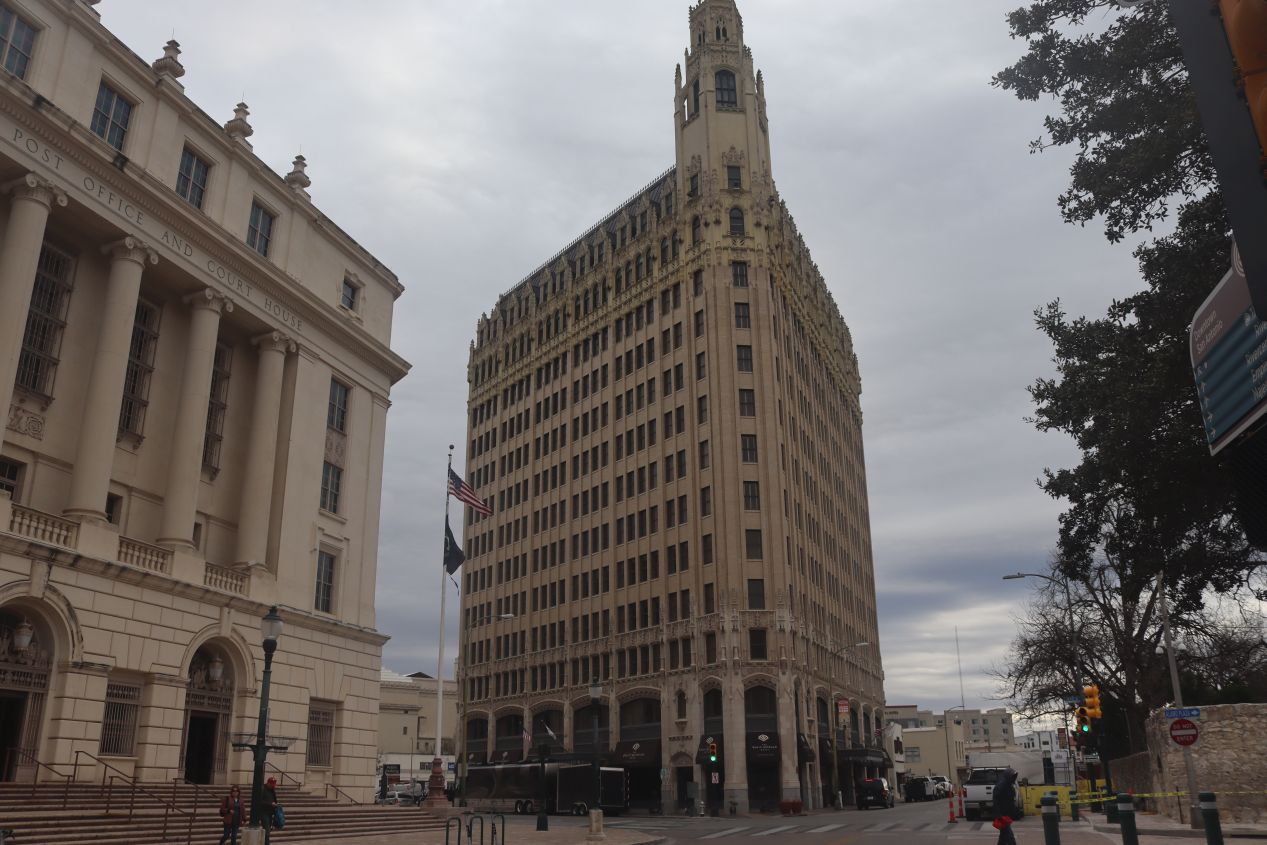


I started out at the northeastern edge of the downtown where I parked within walking distance of the Alamo. The first sights that I noticed were this federal courthouse building along with the oddly triangular building situated next to it. The latter structure was the Emily Morgan building, originally completed in 1926 and previously housing doctors offices and a 50 bed hospital. It was later converted into office space and at time of writing had become a hotel owned by the DoubleTree brand of Hilton. It seemed like an interesting place to stay for a night (and not too unreasonably priced) with a great location near the city's major attractions. Both of these buildings were right next to the public square where the Alamo could be found, where I spotted a bunch of unofficial Alamo-themed gift stores that hadn't opened for the day and a cenotaph memorial built in 1940. The memorial is officially named "The Spirit of Sacrifice" and lists the names of the Alamo defenders who were killed in the 1836 battle. The Christ imagery was certainly strong in this monument.

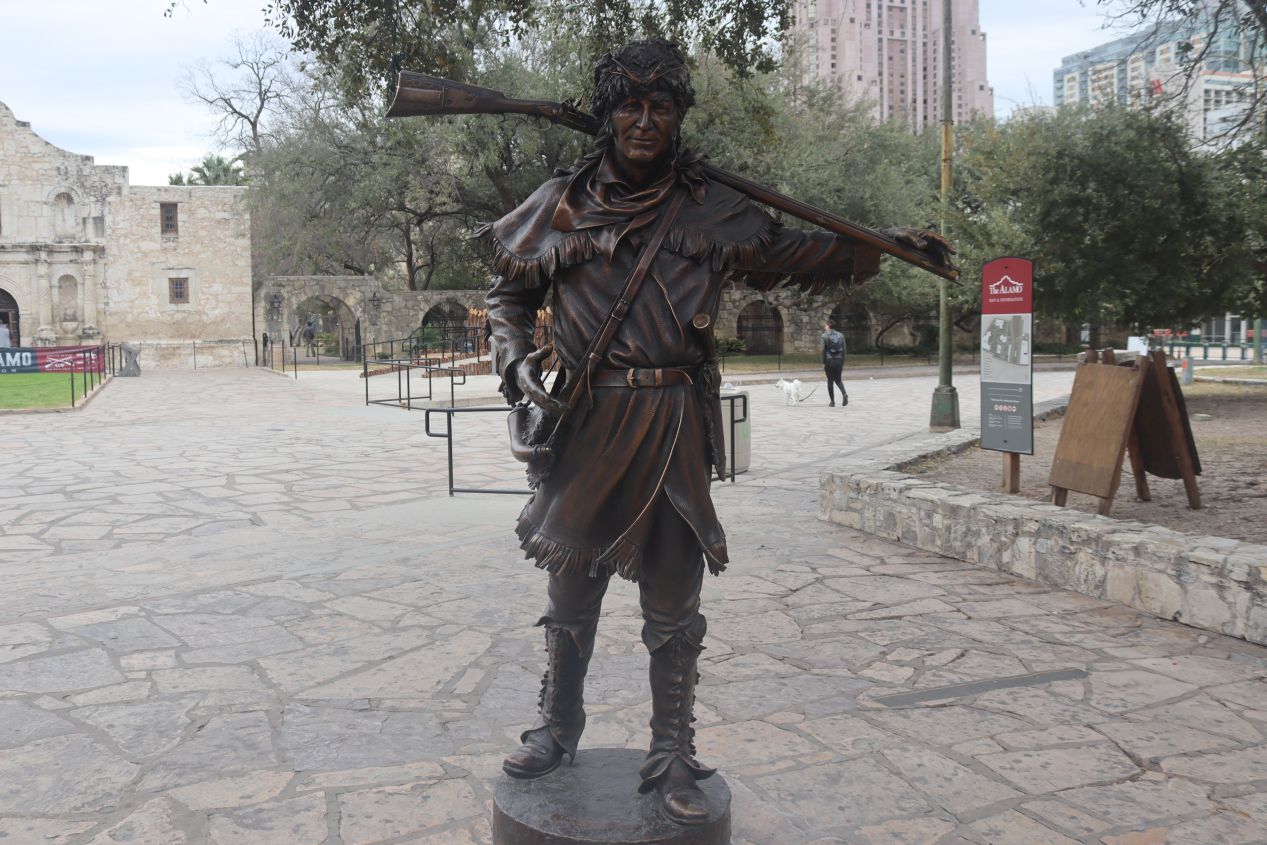


As mentioned above, the Alamo was located right next to the cenotaph memorial and there were only a few dozen people present on this Monday morning in early March. The full name for this place is the San Antonio de Valero mission which was established by Spanish colonial missionaries starting in 1724. The initial goal of the mission was to convert the local Native Americans to Christianity and establish a Spanish presence in the region; at one point in the mid-18th century there were as many as 300 Native Americans living in the area around the mission. Over time, the religious aspect of the mission was lost and it became a secular base for housing soldiers, both under the Spanish colonial government and then also by the Mexican government after it declared independence. During the Texas Revolution in 1836, the Texian rebels seized control of the mission and decided to hole up inside for defense against a Mexican army sent to restore control over the rebelling territory. What happened next has become a part of American folklore: the defenders of the Alamo refused to surrender during the resulting siege and were all killed when the mission was stormed. Their heroic sacrifice helped to provide the inspiration which resulted in Texas achieving its independence later that year. That's the traditional story told about the Alamo, and it was still very much the historic narrative that I found on display at the Alamo, but it's a very one-sided perspective on the conflict that simplifies a much more complex situation. More on this in a minute.
When I first visited the Alamo in the 1990s, my main impression was that the place was a lot smaller than I had been expecting. That remained true on this visit although I had known not to expect anything particularly large thanks to my previous trip. The pictured structure was the mission church of San Antonio de Valero which was surrounded by a series of outbuildings that have mostly not survived down to the present day. As a church that had been constructed initially in the 1700s, this is indeed not a very large structure. Photography isn't permitted inside the Alamo so I'll link to an image of the interior that I pulled from Wikipedia. This was where the defenders of the Alamo made their last stand and structural damage to the building from the siege can still be seen in some places. I walked through the mission church reading the small informational displays that they had inside which didn't take more than about ten minutes in all. Even though I highly recommend visiting the Alamo, there isn't a great deal to see inside the mission church itself.

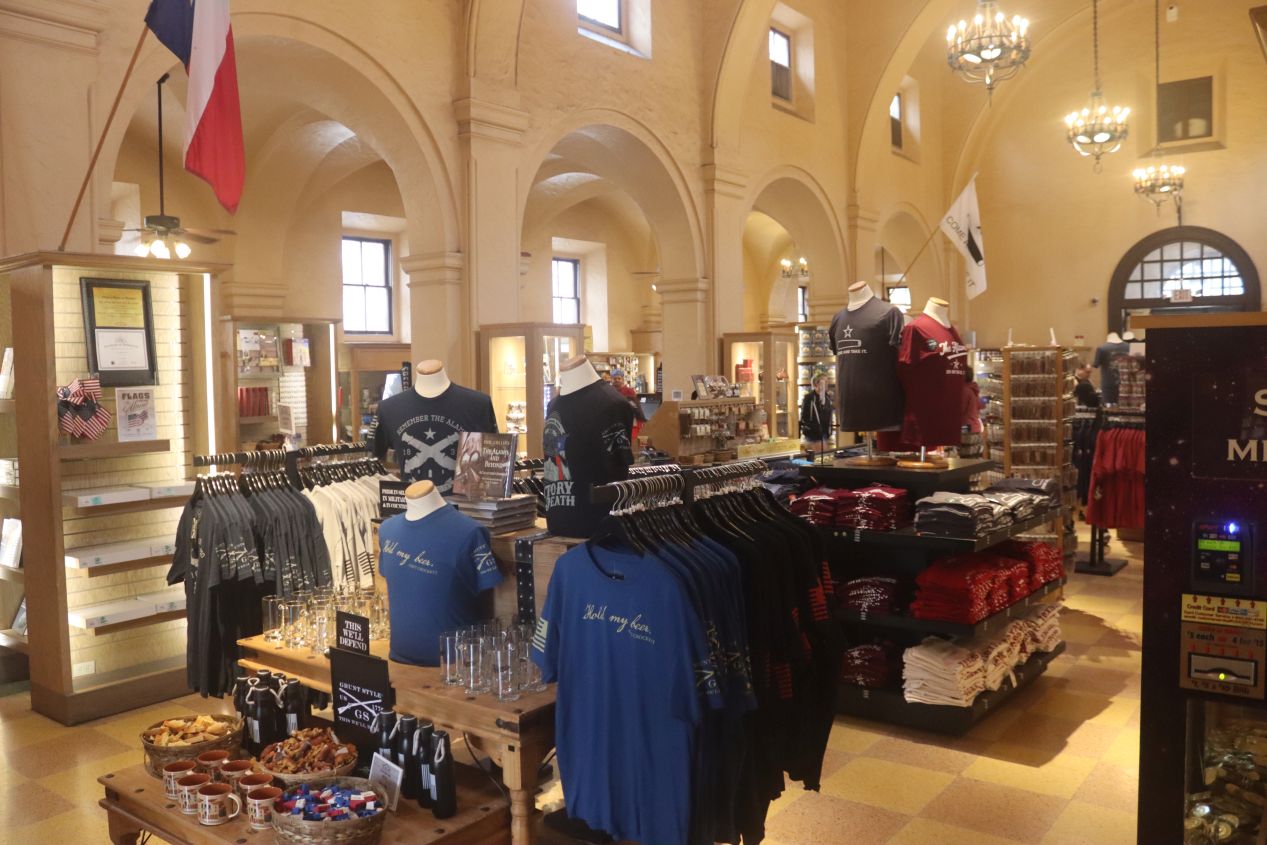


There are a handful of other buildings surrounding the mission church at the Alamo complex. One of them was a much larger visitor's center that was under construction at the time of this visit in 2022 which would hopefully modernize the visitor experience and provide more context on the battle that took place. There was also the building pictured above which looked like something historic but was in fact a gift shop constructed in 1936 that had no connection to the siege whatsoever. There were lots of souvenirs for sale inside bearing "Remember the Alamo" and "Come and Take It" slogans, usually with guns or cannons displayed next to the writing. The siege at the Alamo is rather unfortunately used as inspiration for a number of right-wing militia groups who view themselves as modern freedom fighters. Outside the gift store was a small courtyard containing statues of some of the men who fought in the siege or elsewhere during the Texas Revolution. The weather was cold and very windy on this day, unseasonably so for southern Texas, and I remember being freezing cold when I was walking around those statues. My previous visit had taken place in the middle of summer and it hadn't been anything like this!

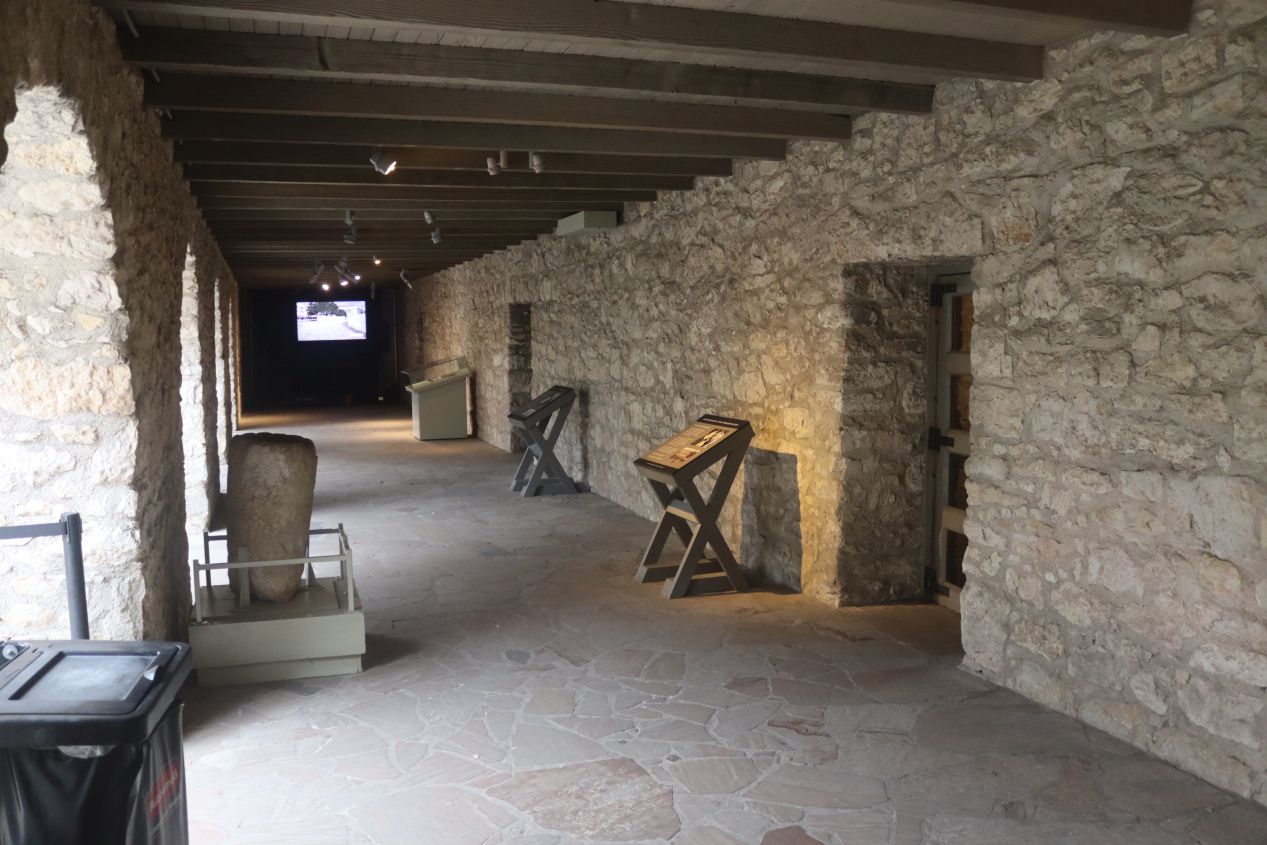


The only other part of the historic Alamo compound that has survived to the present is the stone barracks pictured here that runs next to the mission church for about 100 feet / 30 meters. There was a large tree with spreading branches growing here in the courtyard next to the mission church where visitors continued to leave flowers to commemorate the memory of the defenders that fell in the siege. There was also a series of historical displays that walked visitors through the background of the Texas Revolution; as best I could tell, they looked to be a couple of decades out of date and didn't reflect modern scholarship on the Alamo. All of the historical materials on display at the Alamo told the traditional narrative of (white) English-speaking settlers engaged in a heroic struggle for freedom against an oppressive foreign government. But this presents an overly simplistic portrait of the Texas Revolution; this region had been under Spanish and then Mexican control for well over a century at the time that the revolution broke out in 1835. Texas was a sparsely-populated frontier region at the time and the Mexican government was understandably suspicious of the English-speaking, Protestant settlers who began pouring over the border in the 1820s and 1830s. In particular, those settlers arriving from the southern United States were bringing their slaves with them and that conflicted with Mexico's abolition of slavery in 1829. When the Mexican government tried to establish tighter control over the region, those settlers declared their independence which led to the eventual siege at the Alamo. This has resulted in the conflict typically being portrayed as freedom-loving white Texans fighting against the despotism of non-white Mexicans - not exactly a great look from the perspective of the 21st century.
This is not to say that the traditional story of what took place at the Alamo is wrong either. The Texian settlers did not feel that they were represented by the Spanish-speaking, Catholic individuals that controlled the Mexican government over a thousand miles away to the south. And no one can deny the bravery of the individuals who willingly chose to fight to the death rather than surrender the mission church at the Alamo. However, those same individuals were also fighting for the chance to bring enslaved people into Texas and to exclude the Spanish-speaking Tejano population of the region from any sort of political power. These groups were simply written out of history and their stories ignored in the United States until recent decades. I thought it was ridiculous that none of the historical materials at the Alamo mentioned slavery at all, given that it was the single biggest factor that sparked the Texas Revolution. The Alamo needs to do a better job of explaining the events of the revolution not just from a white Texian point of view but also as seen by the Spanish Tejano and black enslaved populations as well. We can admire the heroism of men like William Travis and Jim Bowie while also pointing out that the Texas Revolution was a disaster for many people who were not part of the white settler class.

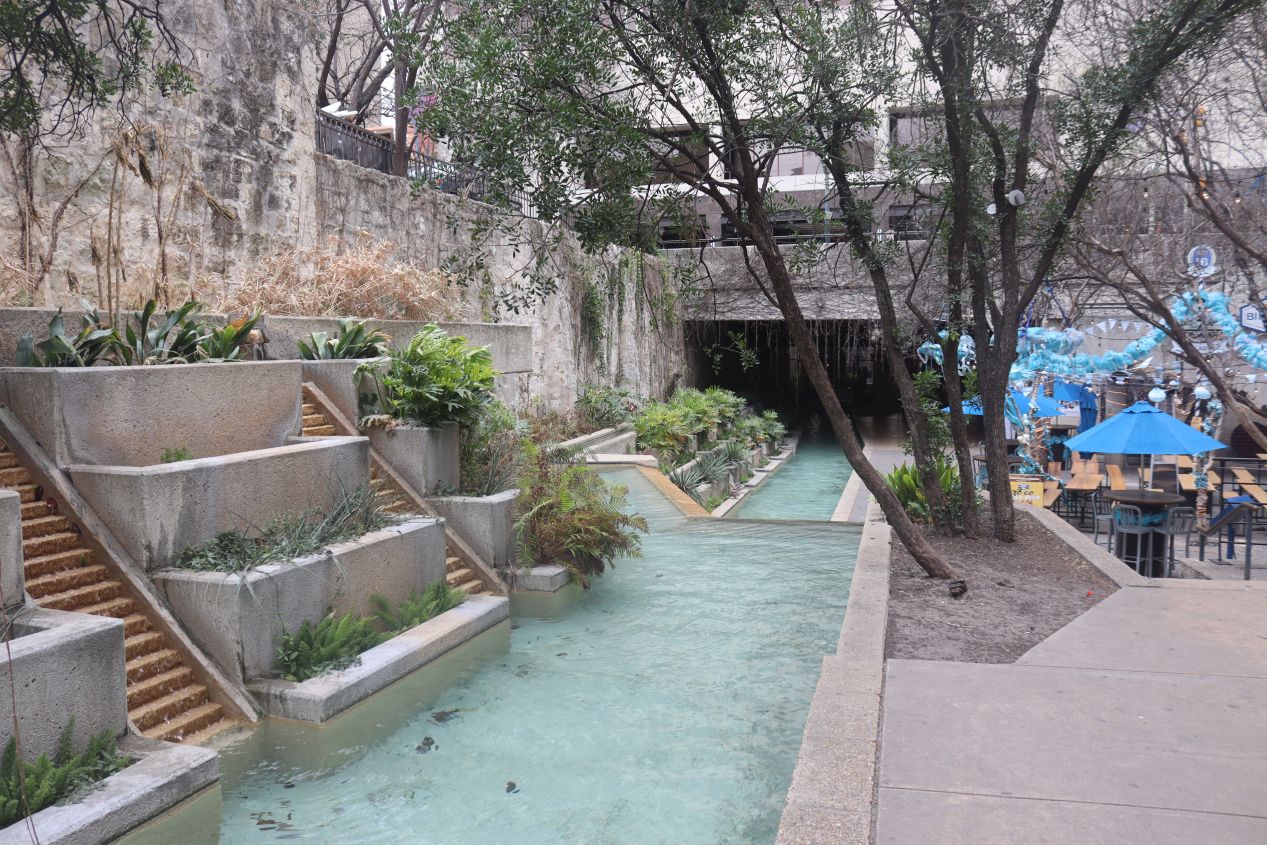


It was a short walk past the cenotaph to the entrance of San Antonio's other famous tourist attractions, the River Walk. This is a winding pedestrian route located below street level that follows the bends of the San Antonio River as it winds through the middle of the downtown. The River Walk began as a Depression-era project to control the flooding of the river that killed more than 50 people during a disastrous period of heavy rain in 1921. San Antonio native architect Robert Hugman had the brilliant idea to turn the area surrounding the river into a commercial development zone rather than paving over everything and burying the river underground. After a slow start, the River Walk took off in popularity following World War II as restaurants and stores and hotels began to cluster along its banks. Since then, the River Walk has repeatedly expanded over the years to stretch to the convention center and north to the city's museum district. This is the heart of the tourist district and it's a true pleasure to stroll along the River Walk enjoying the sights and sounds of the people passing by.

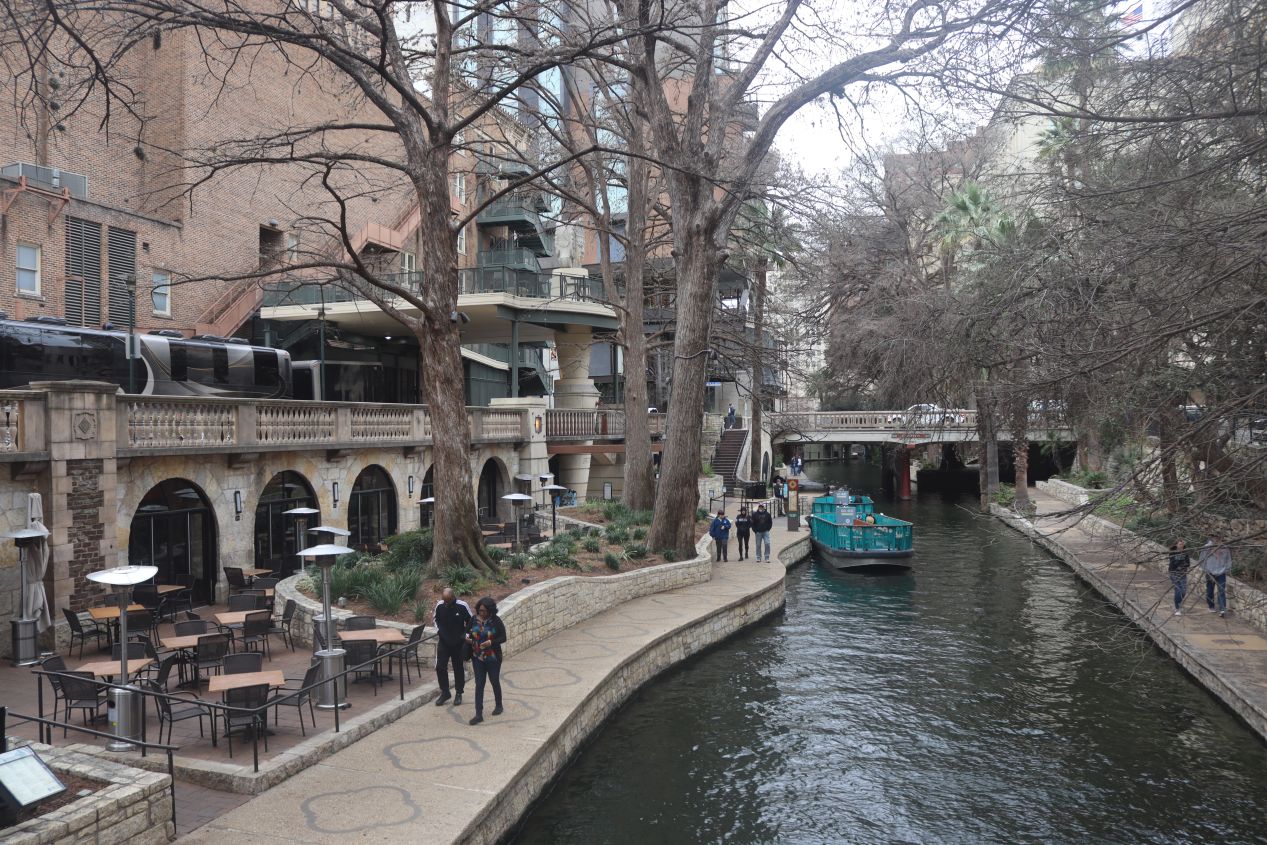


When I visited San Antonio for the first time back in the 1990s, it was the middle of the summer and the River Walk was packed with visitors exploring the shops and restaurants. The experience was quite a bit different on a cold morning in early March, with the walkways mostly deserted aside from a handful of joggers and the occasional local residents out for a walk. There were few other tourists, the boats that would be crowded with passengers in the summer were barely running, and many of the stores were closed. While that could be viewed as depressing, I actually enjoyed the chance to see the River Walk outside of the busy tourist season when it was mostly being used by the people of San Antonio. It was still a beautiful place to walk and I already knew what it looked like when the weather was warm and the trees were green.

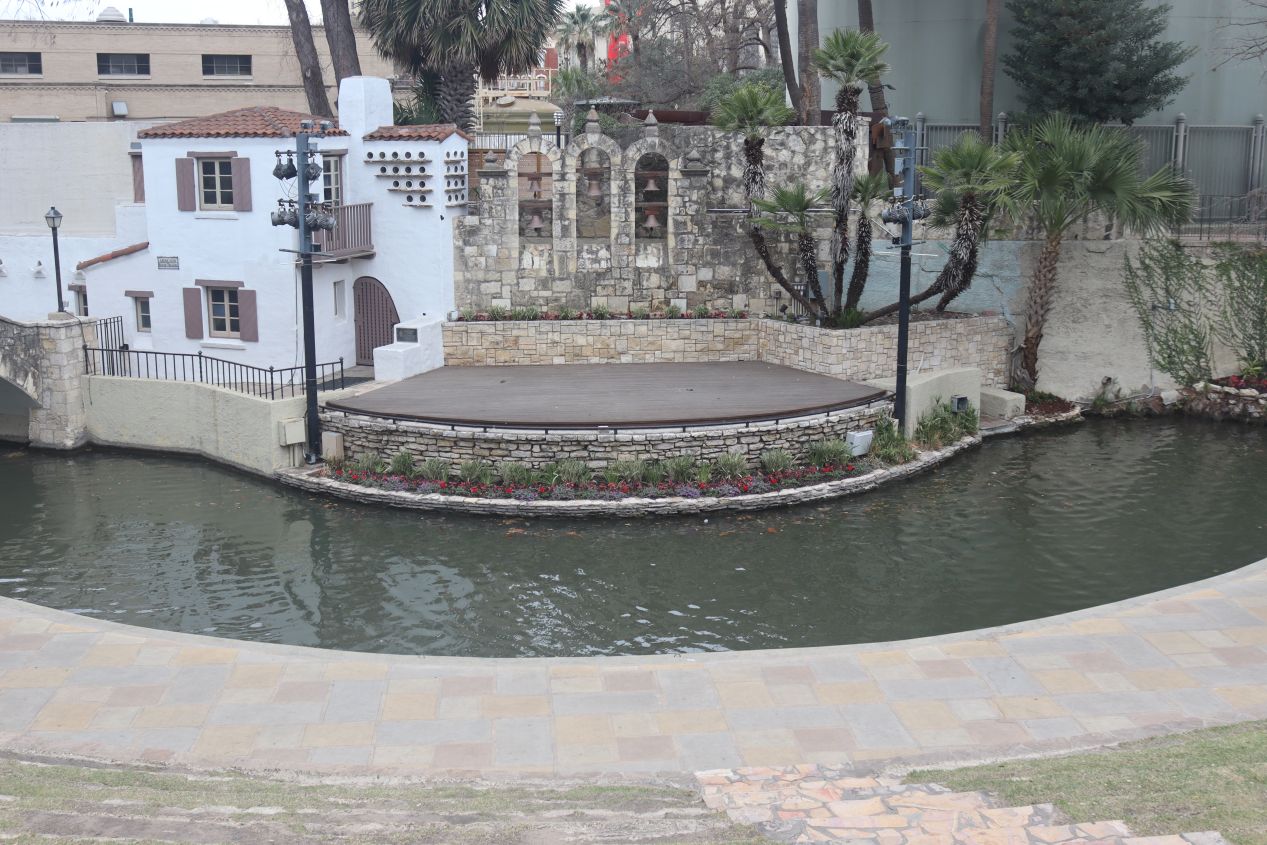


At the southern end of the River Walk was this open air theatre tucked into a bend of the river. This was the Arneson River Theatre, constructed between 1939 and 1941 by the Works Progress Administration as part of the Depression-era funding that helped to create the River Walk. The theatre is used more than 200 times per year on average for all sorts of festivals, music concerts, plays, dances, operas, and even weddings. I remember that there was some kind of show taking place when I visited San Antonio for the first time although of course I can't remember what it was 25 years later. This is a wonderful place to sit and relax when a performance is taking place. The Arneson River Theatre also contains an archway that leads into the historic arts village of La Villita which was where my feet carried me next:

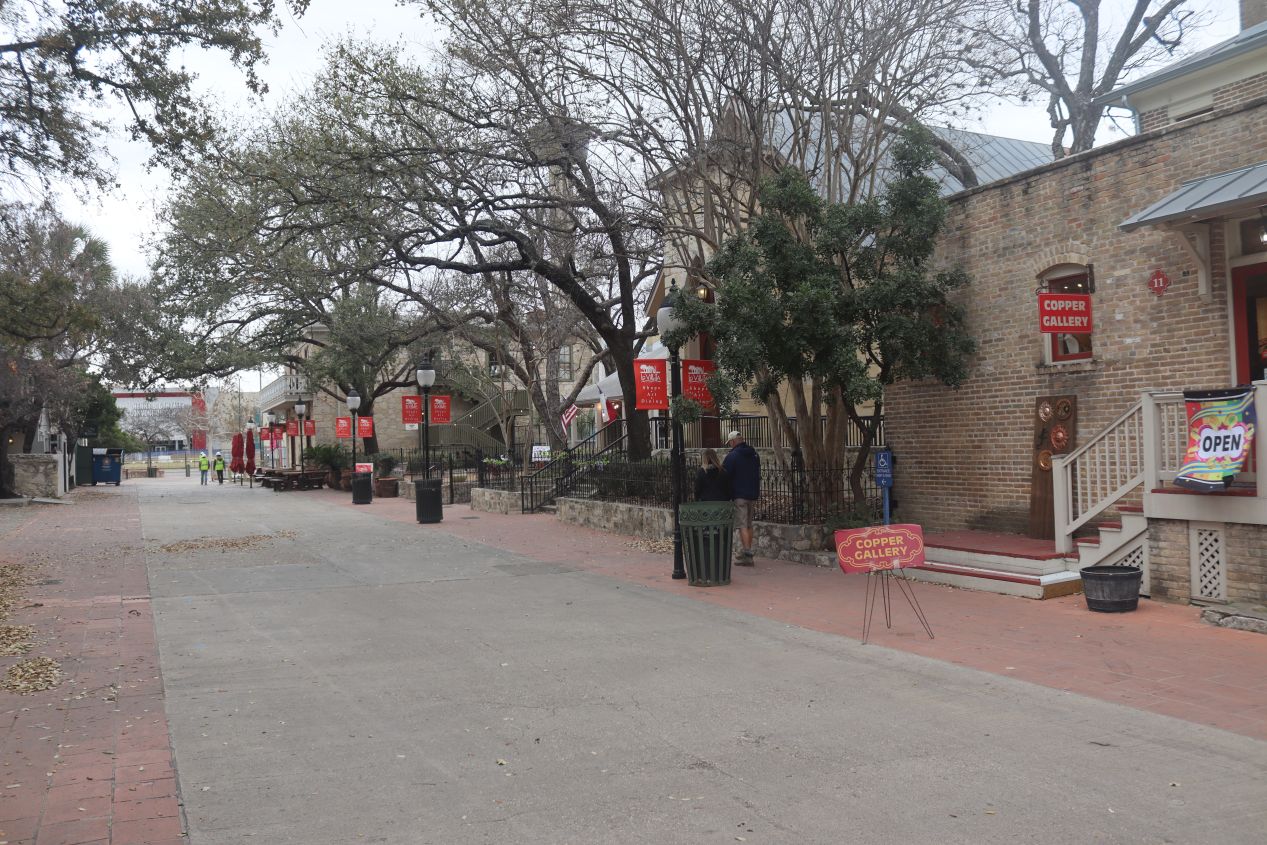


La Villita is an arts community as mentioned above, featuring art galleries, stores selling souvenirs, gifts, custom jewelry, pottery, and imported Mexican folk art, as well as several restaurants catering to arriving tourists. This is a very old neighborhood that dates back to the 18th century when a Native American settlement was located here, which was followed by a small series of adobe houses that were built during the Spanish colonial period to support the mission at what's now the Alamo. La Villita had deteriorated into a slum by the early 20th century and it was revived by the construction of the River Walk which helped to preserve the unique characteristics of the neighborhood. I found it to be a small neighborhood with only a couple of streets comprising the historic district. Everything was open at the time of my visit but there wasn't much foot traffic given that this was well outside of the main tourist season. For anyone interested in the work of local artisans, this is the place to stop in San Antonio.

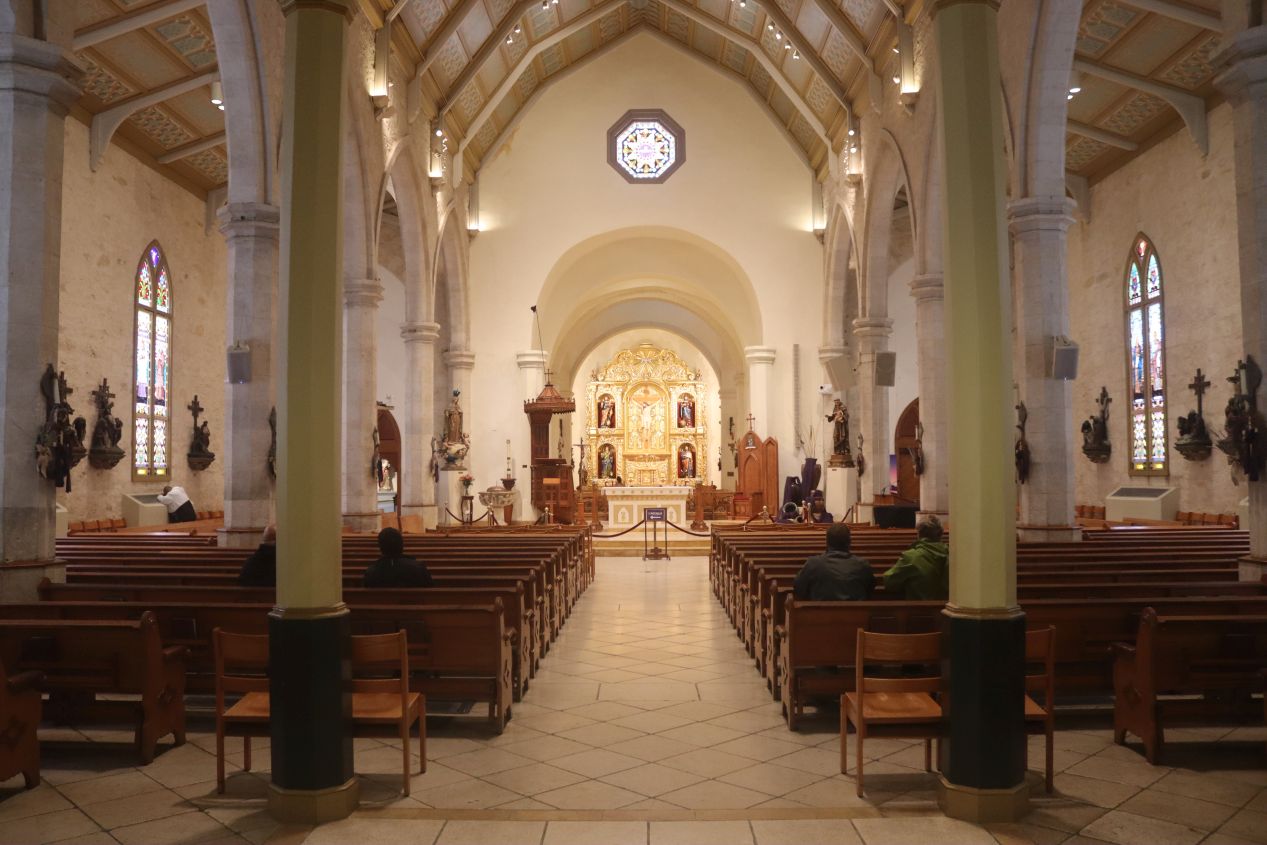


Continuing west past the River Walk and La Villita, I reached the city's main plaza and its oldest church. This was San Fernando Cathedral which dates back to 1738 in the original core of the building and which serves as the seat for the archbishop of San Antonio. While much of the current building in its Gothic form dates from the late 19th century, the sanctuary of San Fernando is significantly older and was present in 1836 as a local parish church. It played a minor role in the battle at the Alamo: Mexican General Antonio López de Santa Anna hoisted a flag of "no quarter" from the church's tower to mark the beginning of the siege and the remains of the Alamo's defenders are still interred at San Fernando. (Their bodies were burned so there isn't much left of them; they are stored in a stone coffin at the entrance of the cathedral.) San Fernando remains at the heart of the religious life of the city, with Catholicism still the dominant religion for San Antonio's residents and this the most prominent Catholic place of worship. There were only a couple of other people present when I stopped in to visit, unsurprising for a Monday morning, and I tried my best to be respectful while snapping these pictures.


San Fernando is located directly in the center of the city and San Antonio's government buildings were right next to it. I passed by the courthouse and the City Hall building that houses the current government to reach this much smaller and older building that dated back to the colonial period. This was the Spanish Governor's Palace and it was built in 1749 to serve as the administrative center for the province of Texas during the era of Spanish colonial rule. In other words, this was the original capital of Texas back in the 18th century; it was certainly much smaller than the current Texas State Capitol that I would visit the very next day in Austin. Unfortunately the Spanish Governor's Palace was closed on Mondays and therefore I wasn't able to enter the building, only take these pictures from the outside. It was yet another reminder of the long-running Hispanic cultural influence on San Antonio that both predated the arrival of the United States and continues to the present day.

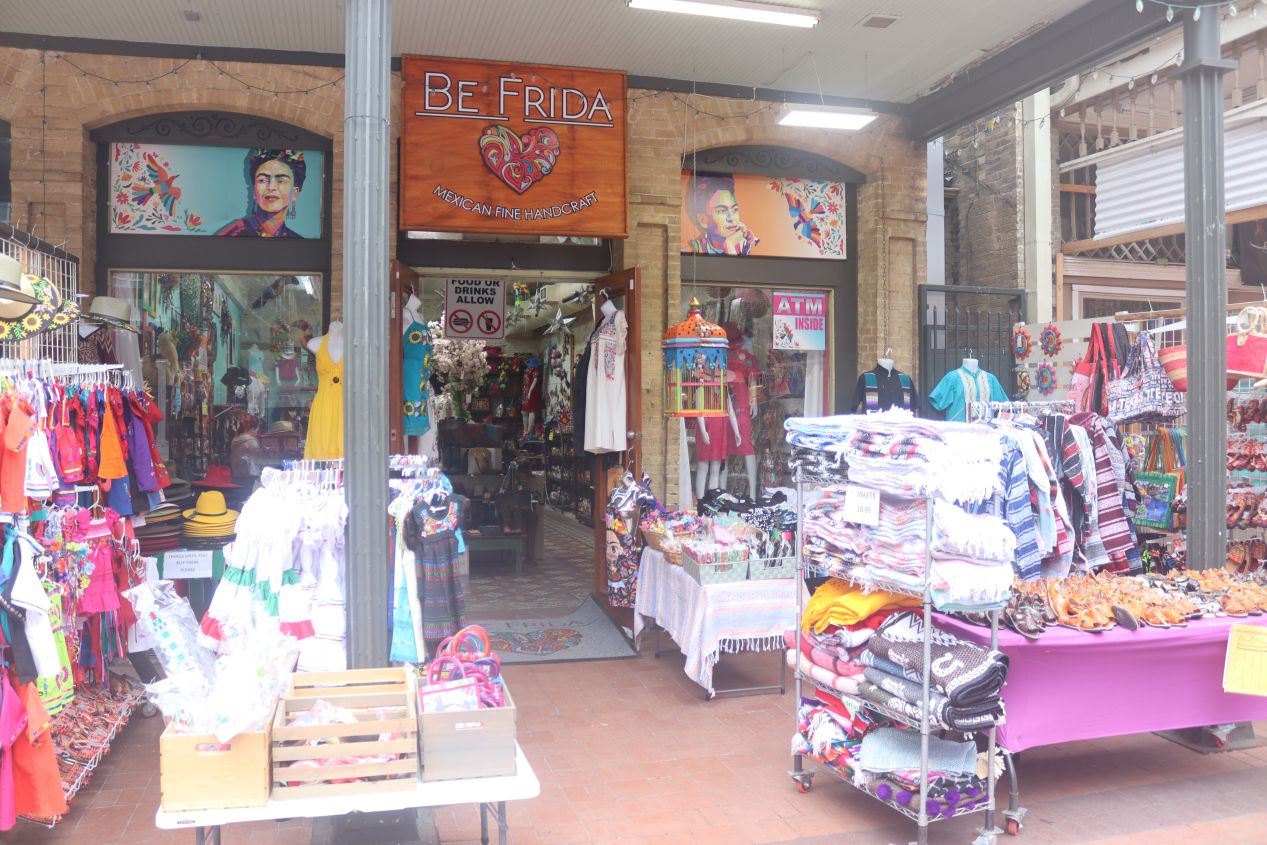


I continued walking westward a few more blocks until reaching the edge of the downtown where San Antonio's historic Market Square was located. This was a three-block outdoor plaza lined with shops and restaurants that claims to be the largest Mexican market in the United States. The Mexican elements were certainly on full display here in Market Square as I saw plenty of handcrafts on sale along with several Mexican restaurants and a stand selling churros. There weren't too many tourists this morning and it was cold enough outside that the one stand advertising warm empanadas for sale seemed to be the doing the most business. In addition to the outdoor portion of the market, there was also an indoor mercado with more vendors offering their wares:

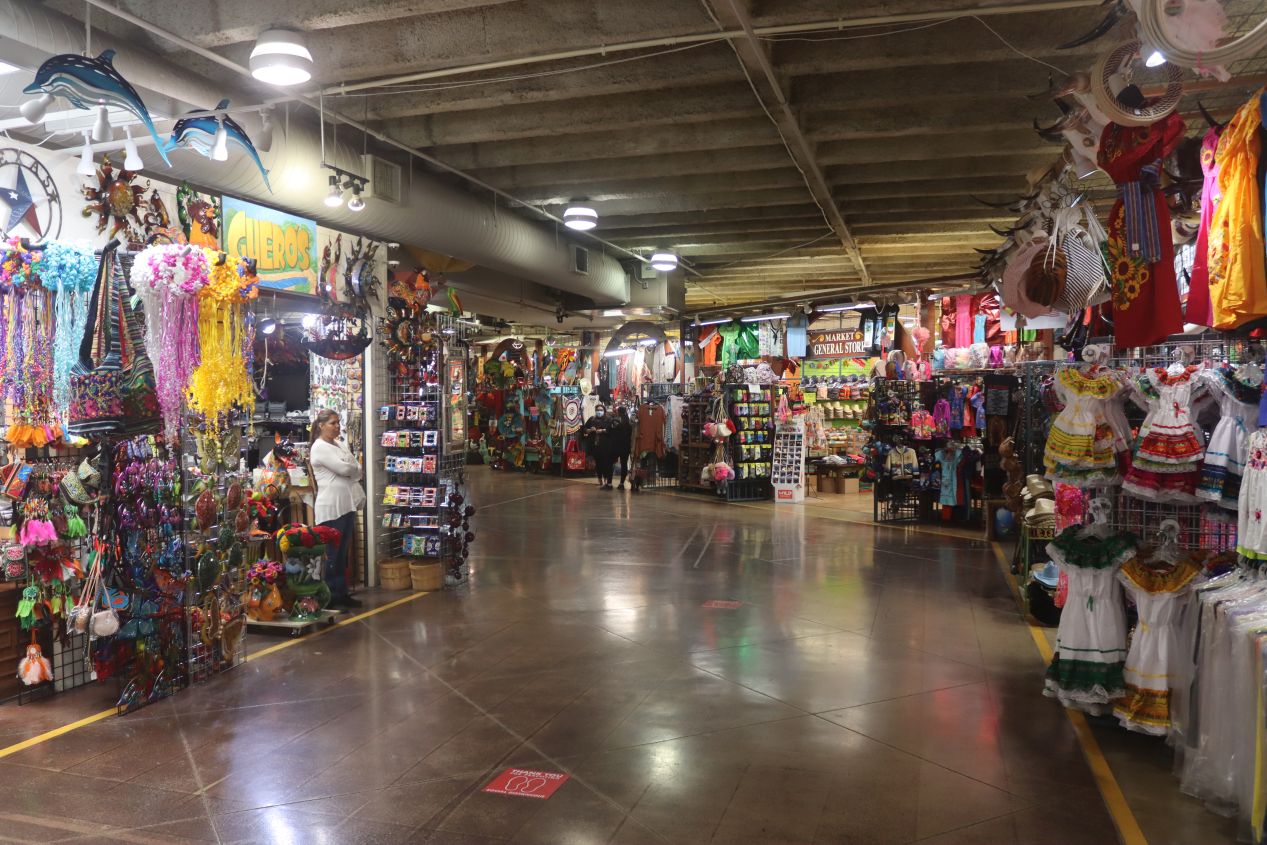


Normally tourists visiting Market Square head into this indoor area because it's air conditioned and provides a way to escape the summer heat. I was heading inside for exactly the opposite reason, as a way to get inside out of the frigid cold!  The indoor portion of Market Square contained dozens of these individual stalls selling lots of tourist stuff, particularly clothing and handbags and blankets. This was another part of the city that felt strongly Mexican in a way that tends to be rare in the United States. Of course there was absolutely nothing strange about that; as I've tried to emphasize throughout this page, the Spanish and Mexican culture were here in San Antonio for a full century before the white Anglo-centric settlers began arriving (to say nothing of the Native American presence that predated them as well). These were the dominant groups in San Antonio 200 years ago and they remain the dominant groups today in terms of population demographics since almost two-thirds of San Antonio's residents identify as Hispanic or Latino. Their perpective has tended to be ignored or suppressed for most of American history but these groups have always been there. So yeah, lots of stuff in San Antonio has a Spanish or Mexican feel to it - why WOULDN'T that be the case?
The indoor portion of Market Square contained dozens of these individual stalls selling lots of tourist stuff, particularly clothing and handbags and blankets. This was another part of the city that felt strongly Mexican in a way that tends to be rare in the United States. Of course there was absolutely nothing strange about that; as I've tried to emphasize throughout this page, the Spanish and Mexican culture were here in San Antonio for a full century before the white Anglo-centric settlers began arriving (to say nothing of the Native American presence that predated them as well). These were the dominant groups in San Antonio 200 years ago and they remain the dominant groups today in terms of population demographics since almost two-thirds of San Antonio's residents identify as Hispanic or Latino. Their perpective has tended to be ignored or suppressed for most of American history but these groups have always been there. So yeah, lots of stuff in San Antonio has a Spanish or Mexican feel to it - why WOULDN'T that be the case?

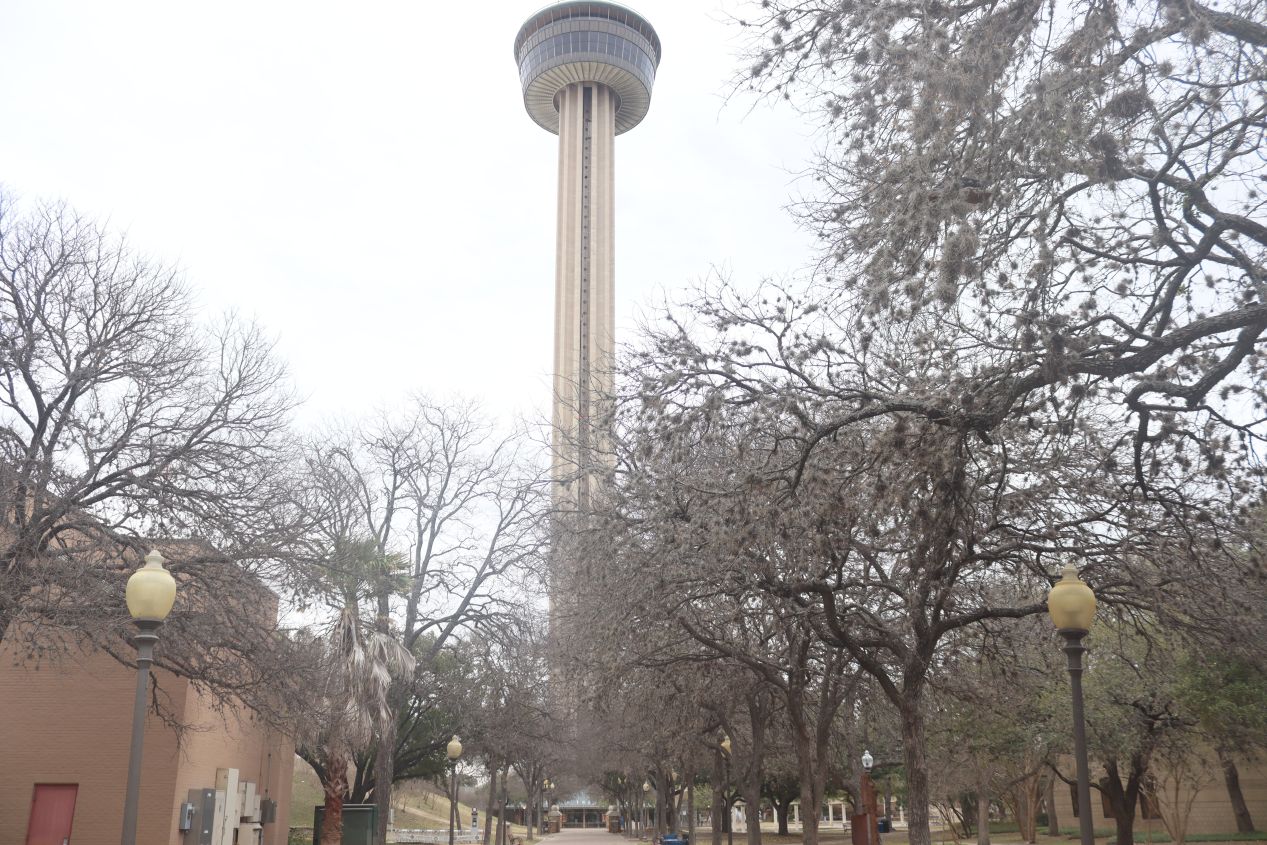


Market Square was situated at the western edge of the downtown with nothing of interest for tourists past it. Once I finished exploring the area, I turned and headed back east again, passing by San Fernando and part of the River Walk for a second time. My route led my past the Henry B. Gonzalez Convention Center which hosts over 300 events annually with more than 750,000 convention attendees. This is one of the biggest draws attracting people to San Antonio if not particularly exciting for tourists. The convention center was right next to something called the Tower of the Americas, a tower that stands 750 feet / 230 meters in height and hosts an observation deck and restaurant at the top. The Tower of the Americas was built for the 1968 Worlds Fair which had the amusing nickname of HemisFair '68. It was the tallest observation tower in the United States for the following three decades and still remains the tallest structure in San Antonio. I thought it would be fun to get a bird's eye view of the city and walked over to the tower, where there were only a handful of other tourists present and I could head immediately into the big elevators for the ride up to the top.


The top of the Tower of the Americas had a circular walkway with informational displays regarding the six flags that have flown over Texas. I would see this same focus on the "six flags" the next day in Austin and they refer to colonial France, colonial Spain, the Mexican republic, the Texas republic, the United States, and the Confederacy. Once again there was no mention at all of slavery or its role in prompting the Texas Revolution or the American Civil War which is utterly astonishing for someone with historical training. The Tower of the Americas badly needs to update these materials since they're providing a distorted and inaccurate portrayal of the past history of Texas. As for the restaurant, it was closed at the time of my visit but looked quite nice, assuming that you would want to hold a business dinner or whatever up at the top of a tower built for a Worlds Fair.

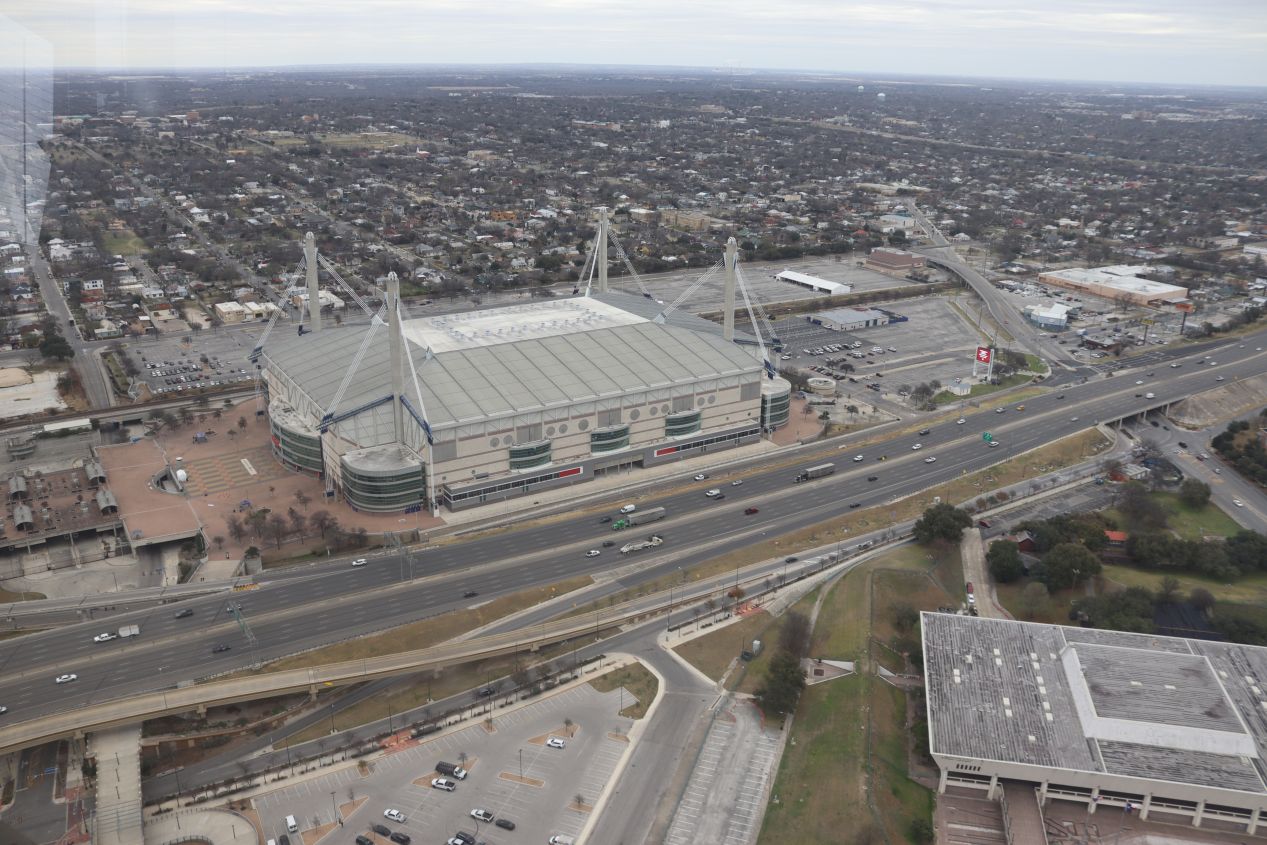


The main reason to visit the Tower of the Americas was the view, of course, and I spent most of my time here gazing out at the surrounding city. There were two viewing areas at the tower's observation deck, an enclosed indoor space captured in the initial image and then an outdoor space that had tall glass windows but was otherwise open to the elements. The view was much better from the outdoor portion of the tower but there was one big problem: it was freezing cold and extremely windy out there! When I mention that it was windy, I mean that when I set down my camera bag on the ground to start taking pictures, the cloth container started blowing away along the edge of the observation deck. I almost lost a camera lens here before I could scramble after the bag and snatch it up. I wasn't dressed for subzero temperatures and had to take these pictures quickly before my hands could get too cold. At least it wasn't crowded - I had the outdoor portion completely to myself as the other visitors stayed inside where it was warm.
The views were excellent from more than 500 feet up in the sky and I was able to see the whole city spread out below. Off to the east across Interstate 37 was the Alamodome, the former home of the San Antonio Spurs that continued to see use as an event center. It was built in 1993 in the hopes of attracting an NFL franchise but failed to land a team due to the opposition of the Dallas Cowboys (and later the Houston Texans). The other major sight line was looking west over the convention center at the buildings in the downtown portion of San Antonio. Unfortunately the River Walk was basically invisible due to the fact that it's located below street level and San Fernando Cathedral was only barely visible tucked in between more modern office buildings. The Alamo was also difficult to spot back behind the big Grand Hyatt hotel; I drew an arrow pointing to it for greater visibility. The historic buildings in San Antonio were pretty small compared to more recent construction and that made them tougher to spot from this vantage point.

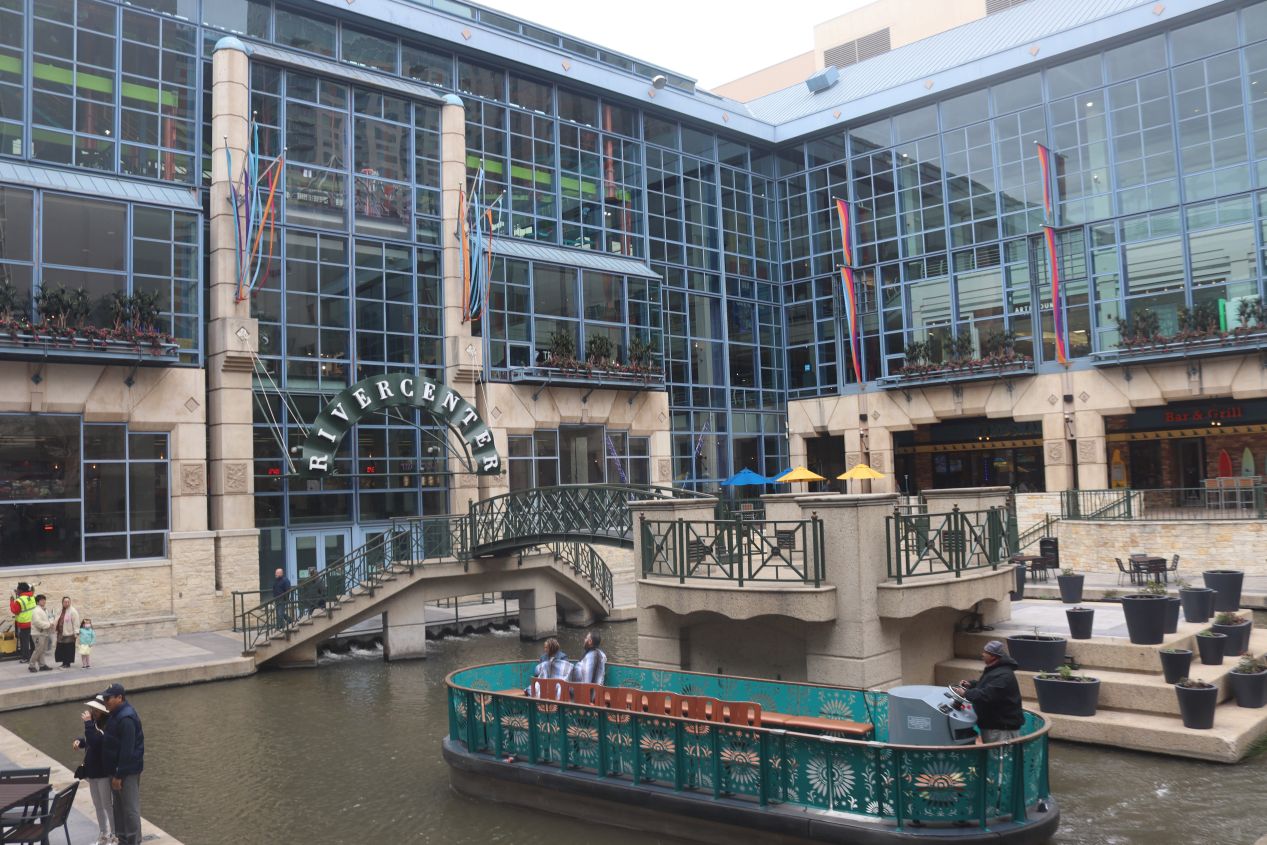


I took the elevator back down to the ground floor and departed the Tower of the Americas, heading north back towards where I had parked the rental car. There was a small arm of the River Walk here that ran underneath the mammoth convention center and past the Lila Cockrell Theatre that plays host to various performing arts. This brought me to the Shops at Rivercenter which is a big mall that intersects with the River Walk and serves as a magnet for arriving tourists each year. Rivercenter holds a Sea Life Aquarium, a huge Legoland store, and an expansive food court where I stopped briefly to pick up some lunch. There are more than 80 stores in total at Rivercenter with the complex spanning four floors. This place is a huge tourist trap but still a decent spot to eat a meal at one of its many restaurants.

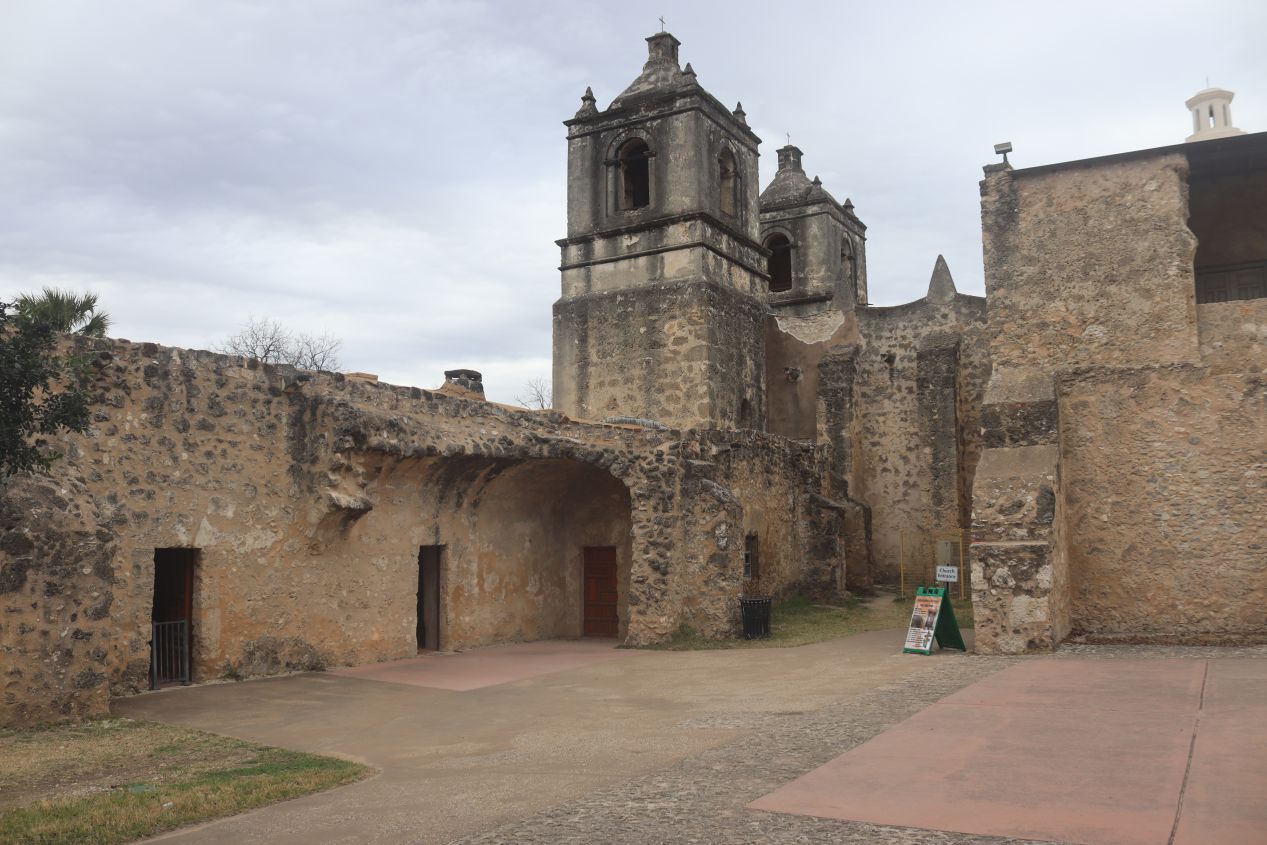


The remaining attractions that I wanted to see in San Antonio were not located in the downtown which meant that it was time to retrieve the rental car and turn on the navigation GPS again. My first stop was a few miles to the south along the San Antonio River at the historic Mission Concepción. There were originally five missions built in the San Antonio area during the Spanish colonial period, with the Alamo (San Antonio de Valero) being the most famous of those five. Mission Concepción is in the best shape of the remaining four missions and dates originally from 1731 when it was used by Spanish missionaries as a base for converting the local Pajalat people to Catholicism. There's a public park here today that helps preserve the mission which I was surprised to find was built right into an otherwise sleepy suburban neighborhood. There were private houses on the other side of the street not 100 feet away from this building which was nearly three centuries old. The architecture style was typical Spanish colonial, the same style of religious building that I'd seen frequently throughout the American Southwest in New Mexico, Arizona, and California.

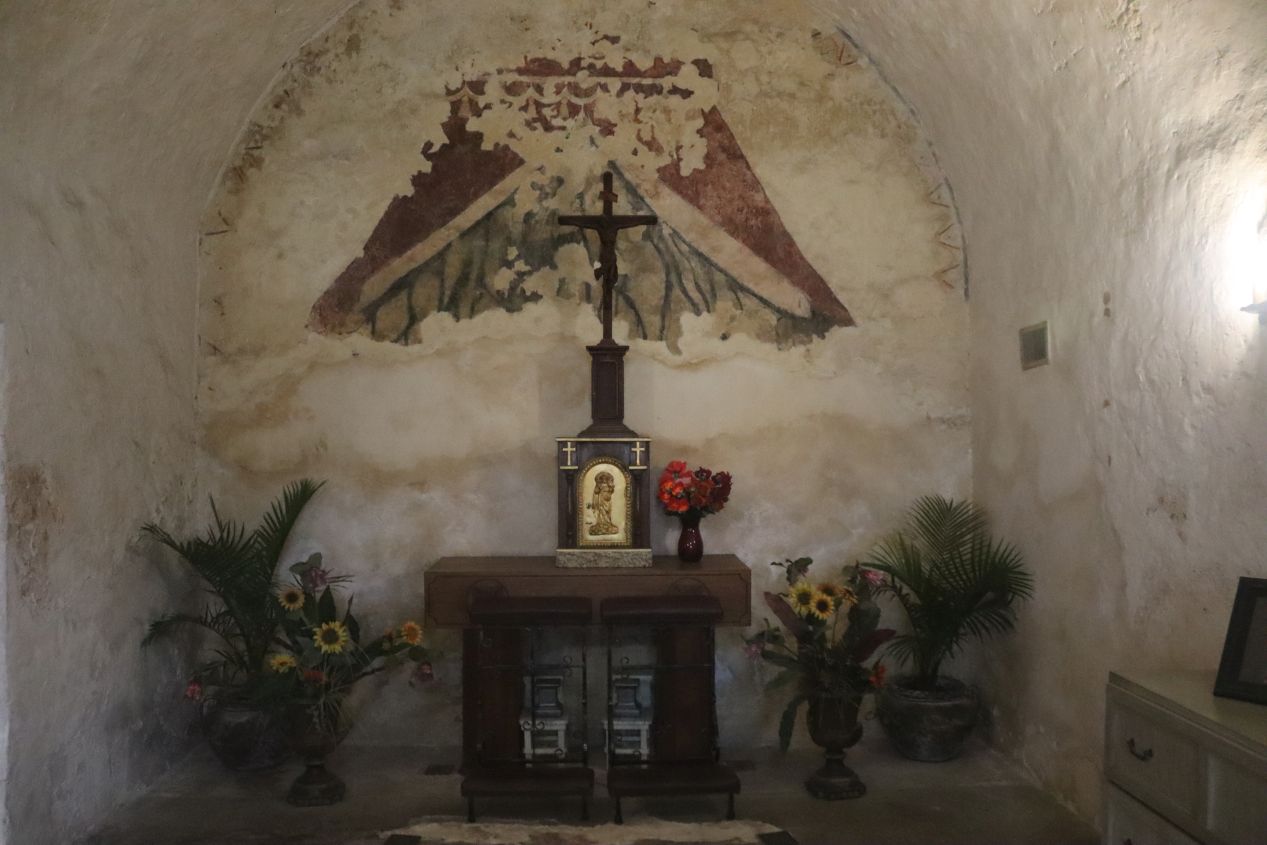


The interior of Mission Concepción definitely felt like a structure that had been standing here for long centuries on end. Outside of the installation of electric lights, it was easy to believe that this stone structure looked much the same as it did back in the 18th century. The biggest change is that the mission originally had brightly painted frescos decorating both the exterior and interior of the building. These have mostly worn away over time although they can still be seen in a few places. The nave of Mission Concepción was relatively small and looked like it could hold about 200 people at a time. One of the neat things about this mission is that it's still an active church that holds services on a weekly basis. While its role has obviously changed over time, I love the fact that this place continues to serve as a place of worship even as its surroundings have changed beyond all recognition.

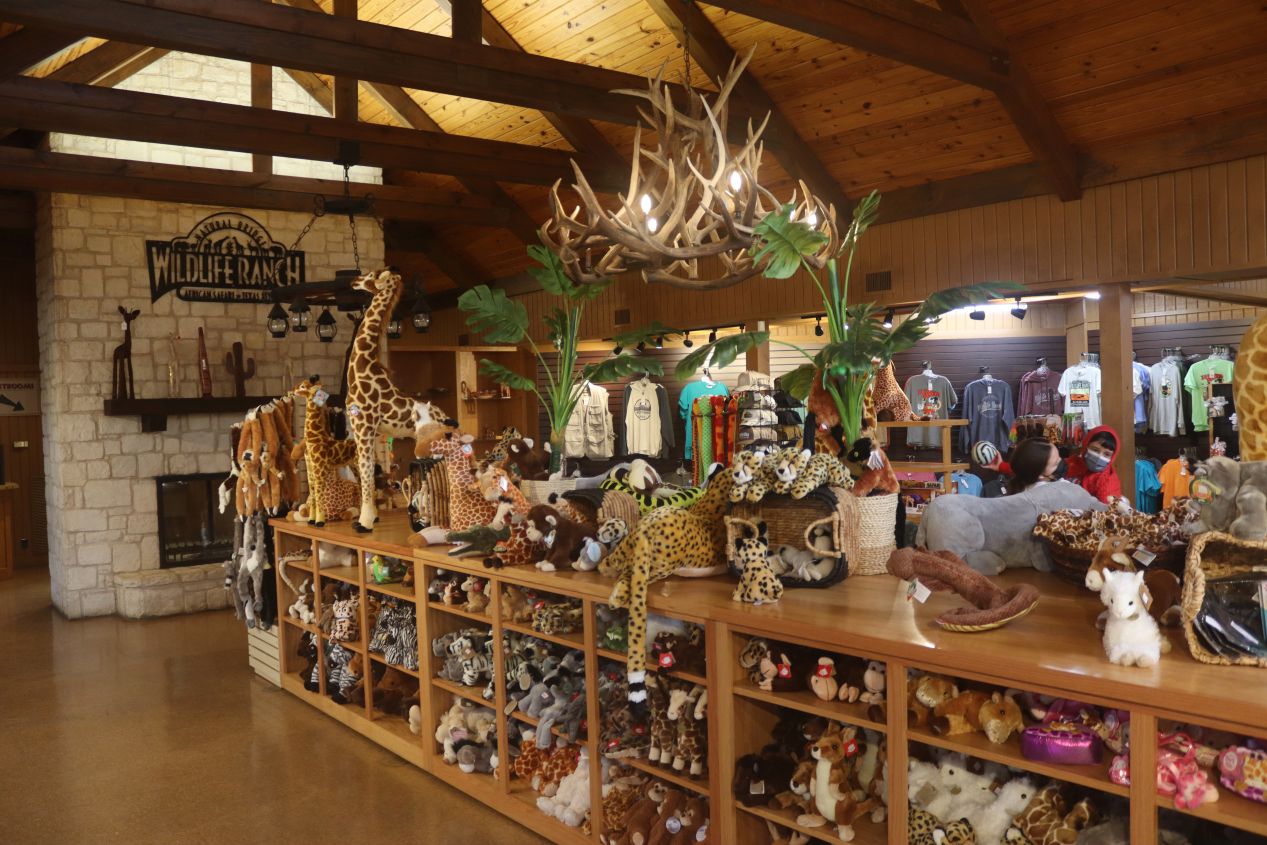


And now for something completely different... I had one more stop to make, this time well outside of central San Antonio. I had read that there was something called Natural Bridge Caverns on the northern outskirts of San Antonio near the town of New Braunfels. (This is also the location of Schlitterbahn, quite possibly the best water park in the United States, which I had visited on my previous trip as a teenager. It was closed for the winter and the weather was too cold to make visiting practical on this trip.) Caverns were unchanged under any weather conditions though and I headed off to Natural Bridge on my way back to Austin. When I reached the attraction, however, I saw that there was also an option to visit the newer Wildlife Ranch at Natural Bridge which was advertised as being a drive-through safari experience. That sounded more interesting than seeing some caverns which wouldn't measure up to my earlier trip to Carlsbad and I headed over to the wildlife section instead. These were some pictures of the entrance area at Natural Bridge along with a giraffe enclosure near the parking lot. I've seen giraffes a bunch of times, even fed them once on a previous trip to San Diego, and I'm always reminded of the fact that these goofy animals aren't particularly smart. They're a bit like cows on stilts and don't focus on much other than food.

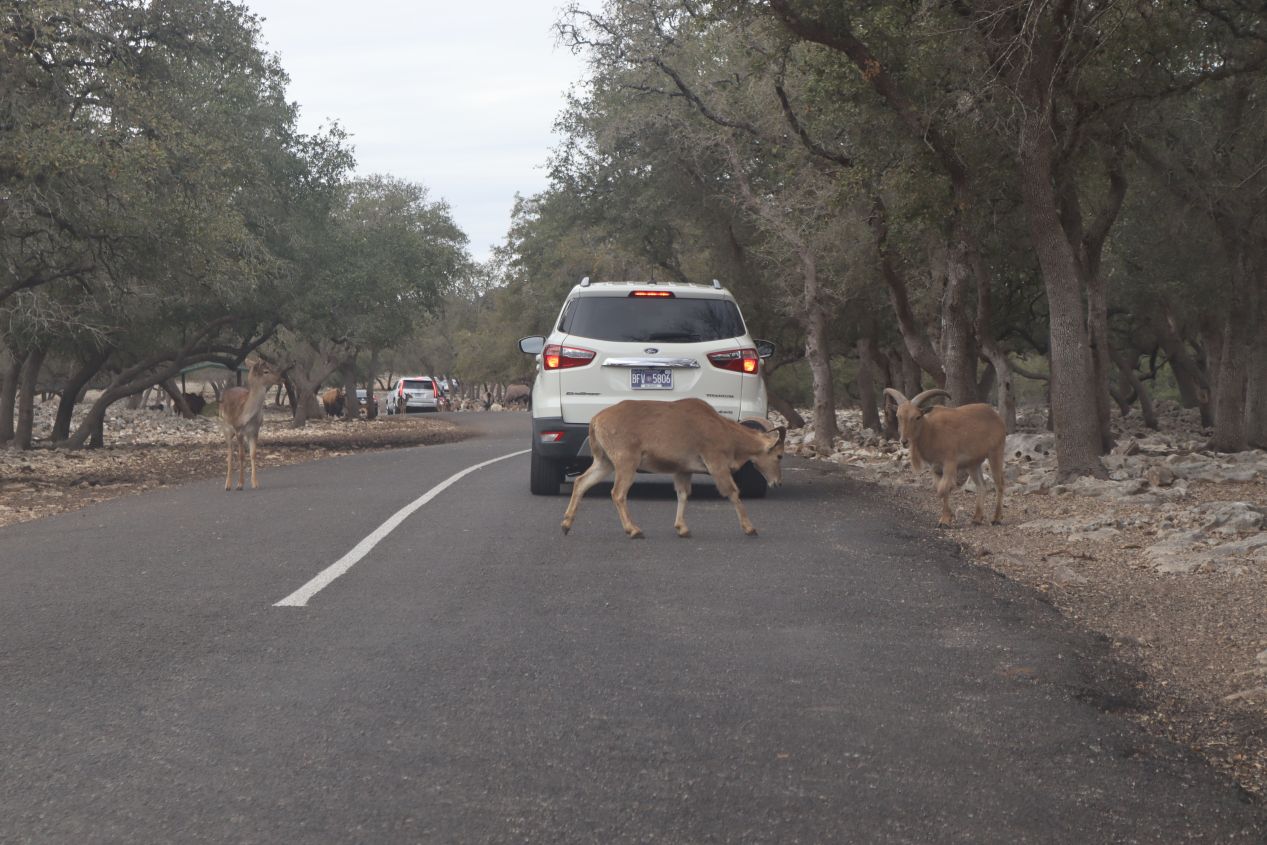


Once I'd had a chance to check out the gift shop and restaurant, I returned to my rental car and began the drive into the safari area itself. Natural Bridge had several dozen different species wandering about in the safari park that were mostly drawn from various part of Africa; I'm going to do my best to identify them correctly but apologies in advance if I get any of these details incorrect. The animals started showing up immediately after my car crossed into the safari area , drawn there by the feed dropped along the sides of the road by visitors and park staff. There were a bunch of goats here near the entrance (the guidebook states that these are an African type named aoudads) and several gemsbok with their long, straight horns.

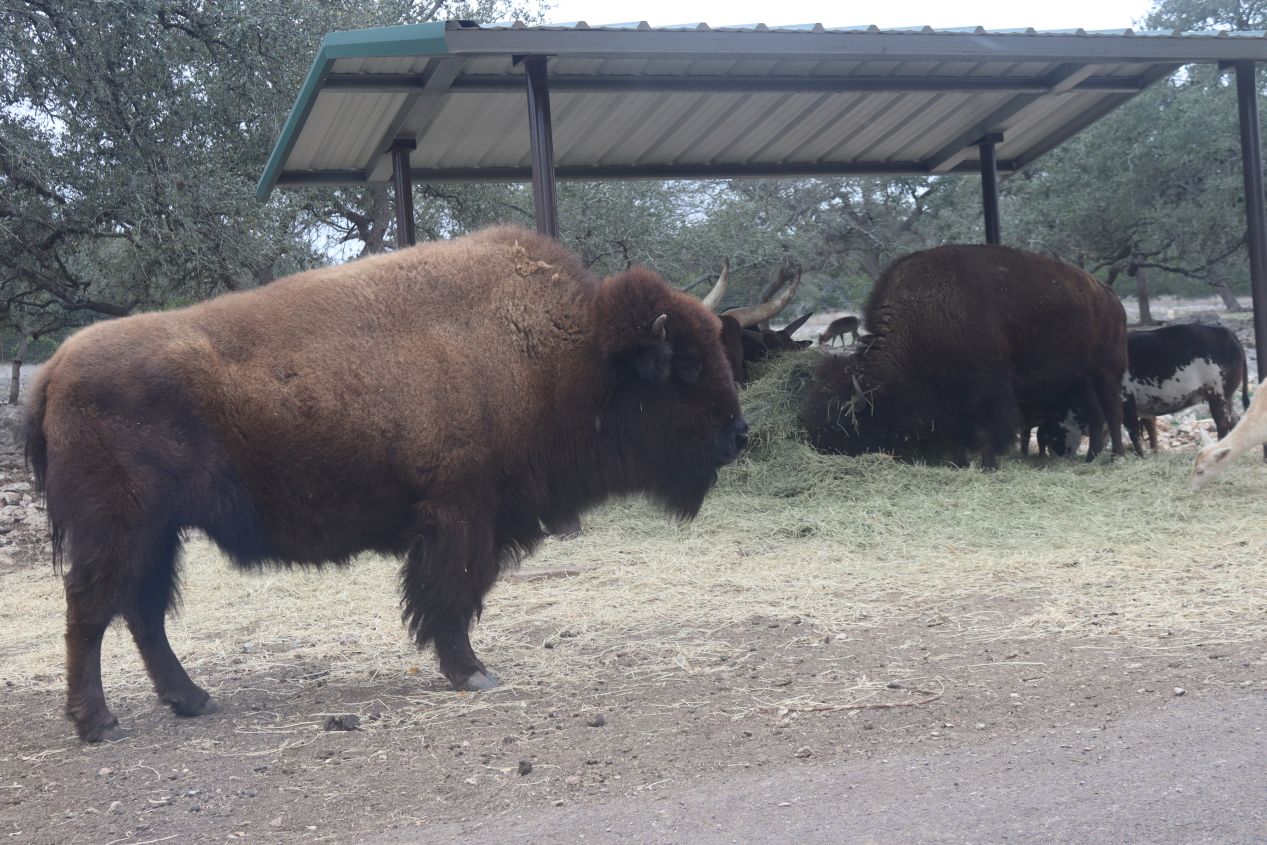


Up ahead was one of the few animals from North America held at Natural Bridge, the American bison or buffalo. These gigantic animals can weight more than 2200 pounds / 1000 kilograms when fully grown and at one point in time could be found in vast herds stretching all across the Great Plains. I had previously seen them in the wild at Yellowstone National Park and the bison on display here seemed to be juveniles that weren't fully grown since they were definitely smaller. The bison seemed to be the largest animals in the safari park and they were likely responsible for the warning signs everywhere telling visitors to stay inside their cars at all times. Bison aren't particularly vicious creatures but they will charge if they feel threatened and their size can make them dangerous to people.

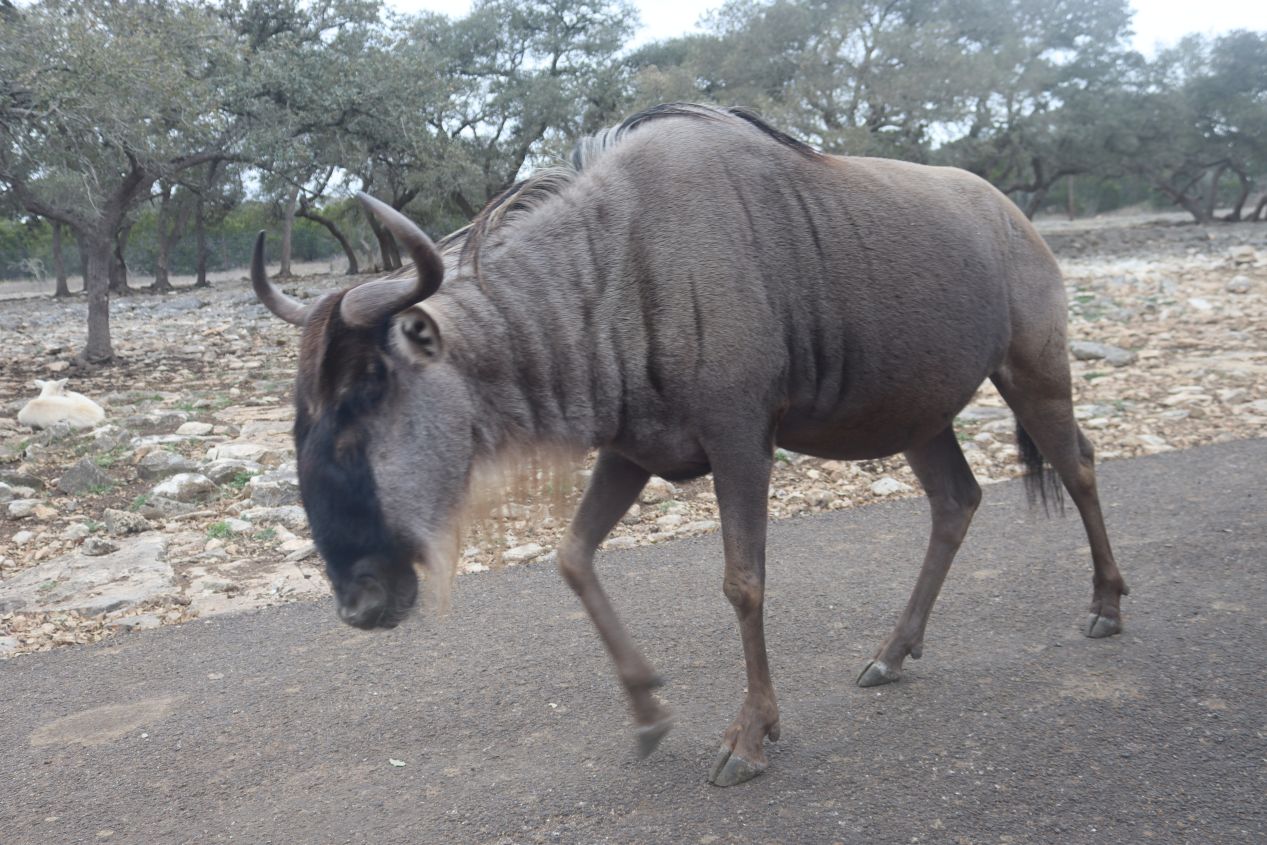


Further up the road I started to encounter wildebeest, best known for their role during the stampede scene in The Lion King movie. Wildebeest aren't the prettiest creatures and they have an odd, awkward-looking way of moving to their gait that I wasn't used to seeing. There were about two dozen of them moving together as a small herd along the side of the road. After they passed the route forward became awfully crowded, including several moments where I couldn't even drive the rental car because there were so many of these little deer in the way. There were two types of the deer listed in the guidebook, one of them from Europe and one of them from India, which I couldn't tell apart because this was the wrong time of year for the males to have antlers. I had to inch the car forwards very slowly so that they would move out of the way and clear the road. Then there was a herd with some kind of oryx towards the end of the initial enclosure. One of these animals came right up to the rental car and I could have reached out and touched it if I hadn't been following the instructions to keep the windows closed.

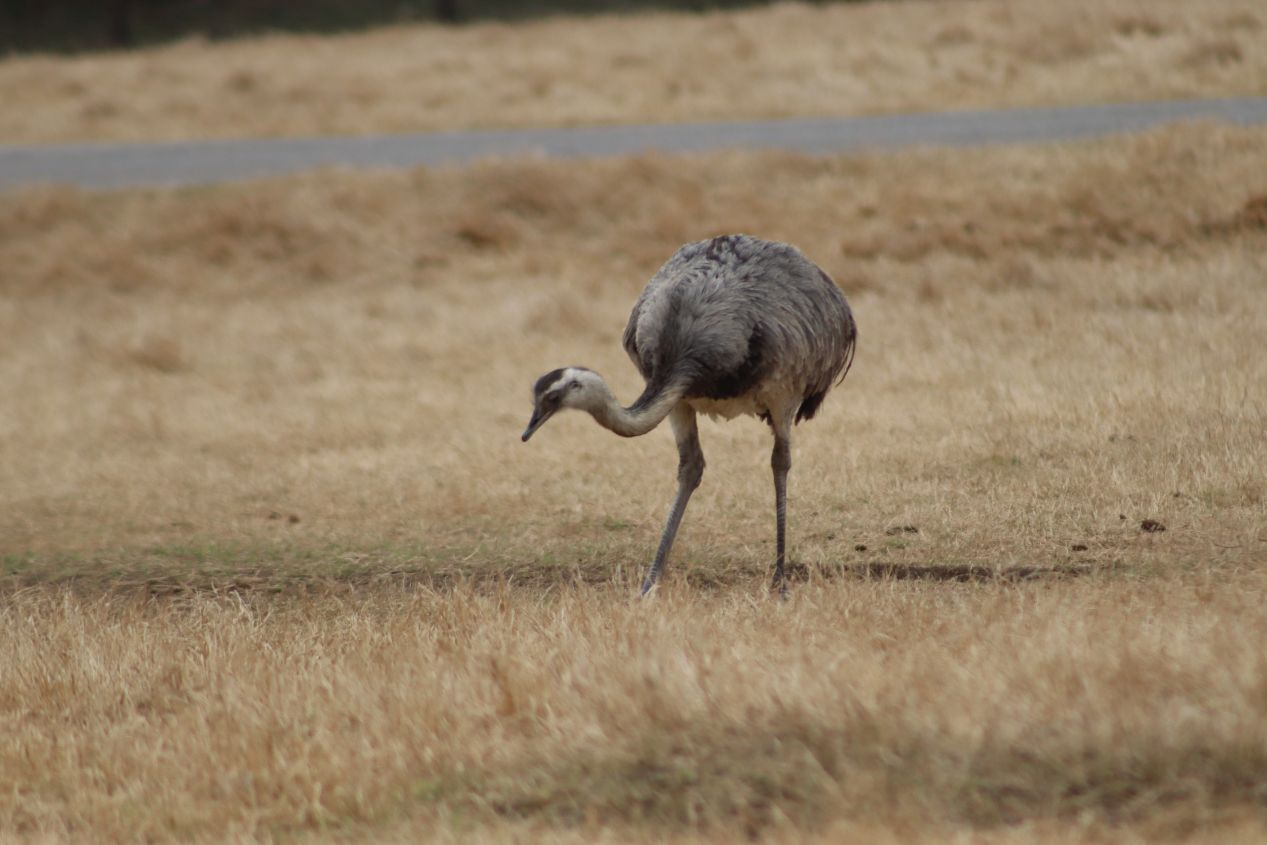


There was more than one section to the safari park; I had started out in the Tatonka Range component and crossed over at this point to the Tower Creek component. This area seemed to be slightly less forested and had more of an open grasslands or savanna feel to it. There was a group of dark-coated sable antelopes resting together here along with a series of large flightless birds. I thought at first that these might be juvenile ostriches but it appears that they were actually a South American bird known as the rhea which are the fourth-largest birds in the world. They were mostly keeping to themselves rather than clustering in larger flocks. I also spotted more oryxes, this time of the Arabian variety, which had some utterly adorable juvenile animals hiding for protection behind the adults. The number of Arabian oryxes is dwindling and they were among the most vulnerable species kept at Natural Bridge.

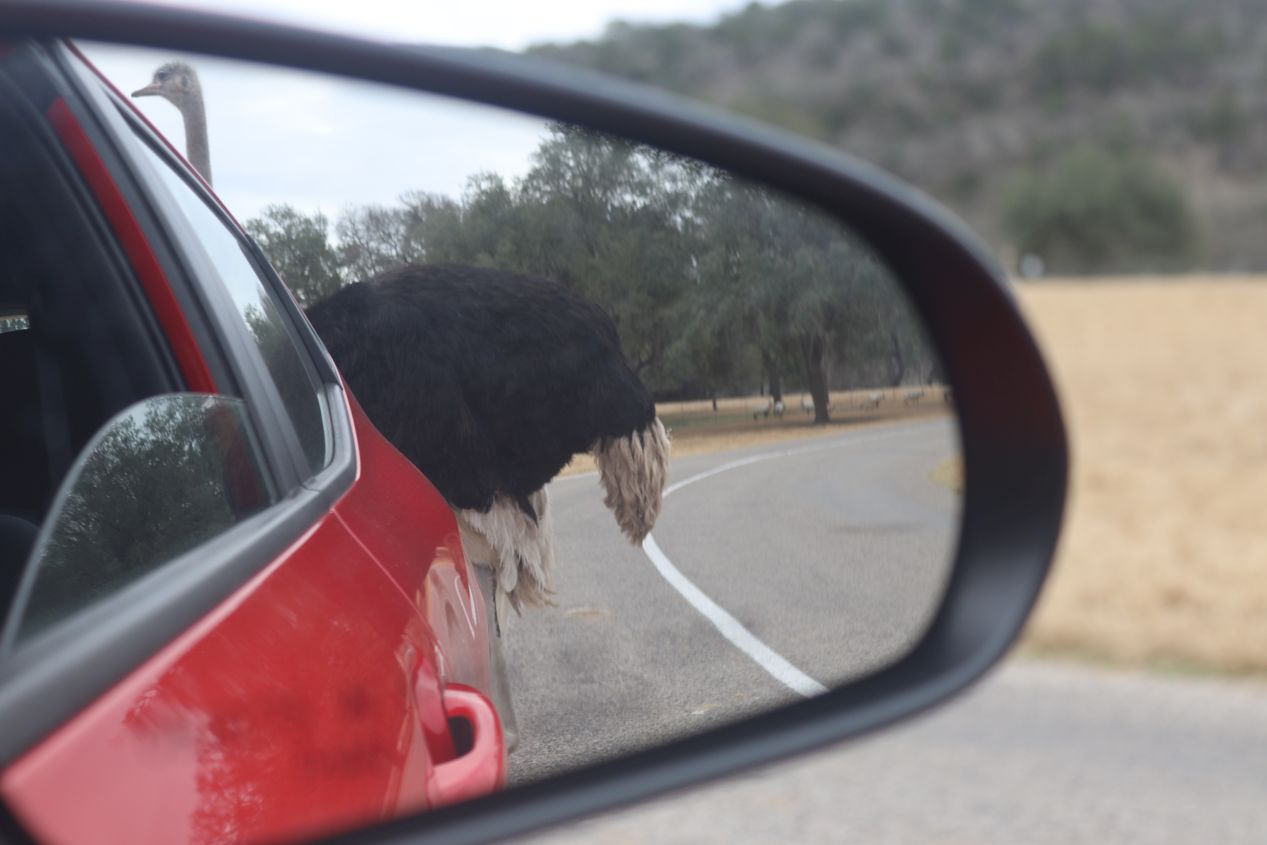


The biggest stars of the wildlife ranch were the ostriches though. There were several of them in the Tower Creek portion of the safari and they weren't shy about coming right up to cars in search of additional food. This ostrich strolled towards my rental car as if were the proper owner of the vehicle, circled around it a couple of times, and then tried its best to get inside the car. It dropped down its head and pecked at the passenger side window several times since it apparently couldn't see the glass, allowing me to capture these awesome pictures. It's pretty well known that ostriches are the largest birds in the world and sheesh, this thing was HUGE up close!  The fact that it had to duck down from its height of 9 feet / 2.7 meters to look into the window of the car was more than a little disconcerting. While ostriches aren't dangerous to people unless provoked, it was easy to see how dinosaurs and birds both evolved from the same common ancestor and birds are now officially classified as a type of theropod. In other words, birds didn't evolve from dinosaurs, birds literally *ARE* a type of dinosaur that never went extinct. Remove the feathers and add teeth and this ostrich could have been one of the raptors from Jurassic Park.
The fact that it had to duck down from its height of 9 feet / 2.7 meters to look into the window of the car was more than a little disconcerting. While ostriches aren't dangerous to people unless provoked, it was easy to see how dinosaurs and birds both evolved from the same common ancestor and birds are now officially classified as a type of theropod. In other words, birds didn't evolve from dinosaurs, birds literally *ARE* a type of dinosaur that never went extinct. Remove the feathers and add teeth and this ostrich could have been one of the raptors from Jurassic Park.

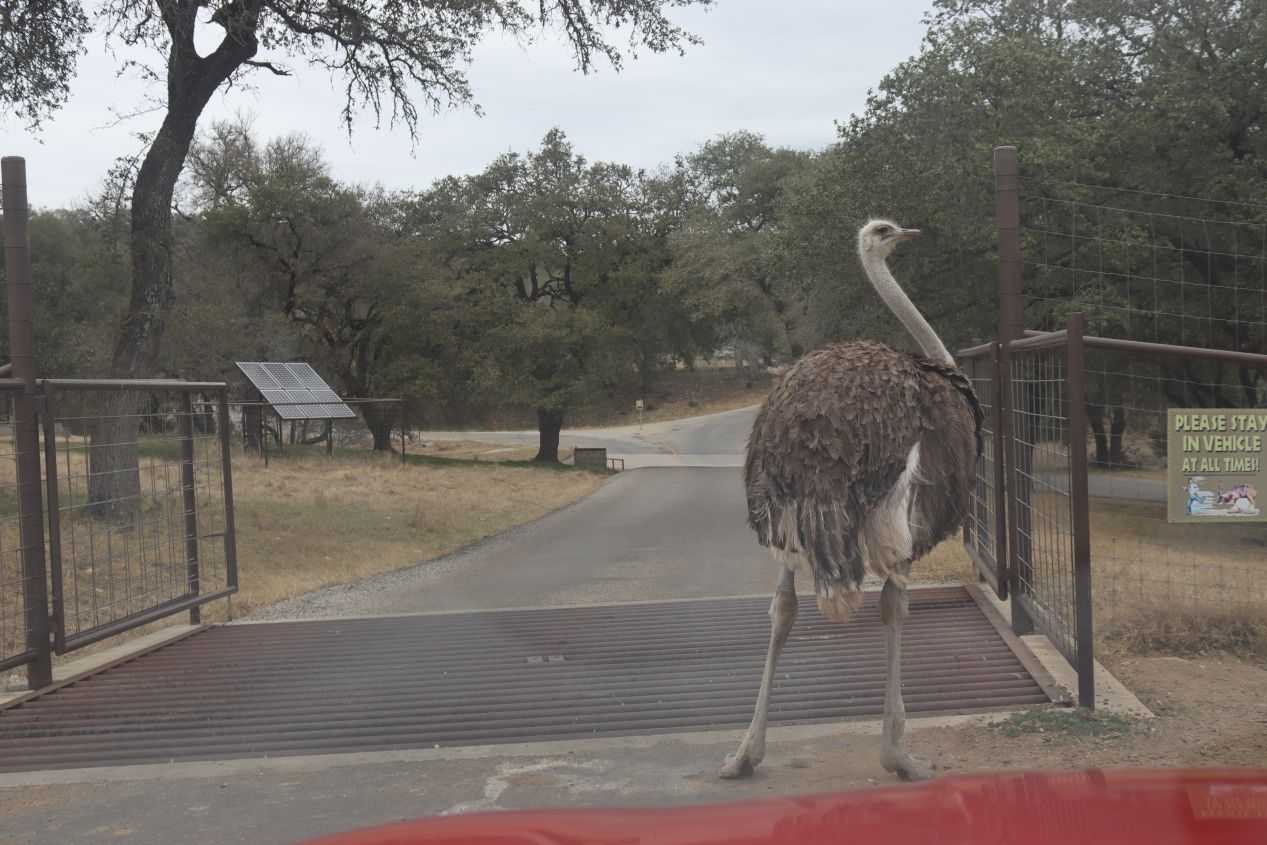


There were additional ostriches that I encountered near the gates leading out of the Tower Creek portion of the safari park. These were identifiable as female ostriches due to the brownish coloring of their feathers, in contrast to the male ostriches like the one that I had just seen which have black feathers. This pair of birds also circled my car but didn't have the same aggressive instinct of trying to peck their way through the windows. As for the other animals with white stripes, those were bongoes which are a type of African antelope. Bongoes are critically endangered with only a few hundred animals still living in the wild and conservation groups are trying to boost their numbers with breeding programs to help the species survive. I should take care to emphasize that this whole experience was downright amazing and it genuinely did feel like being on a safari. I wished that my wife Liz could have joined me since she loves animals and would have gotten a kick out of this drive.

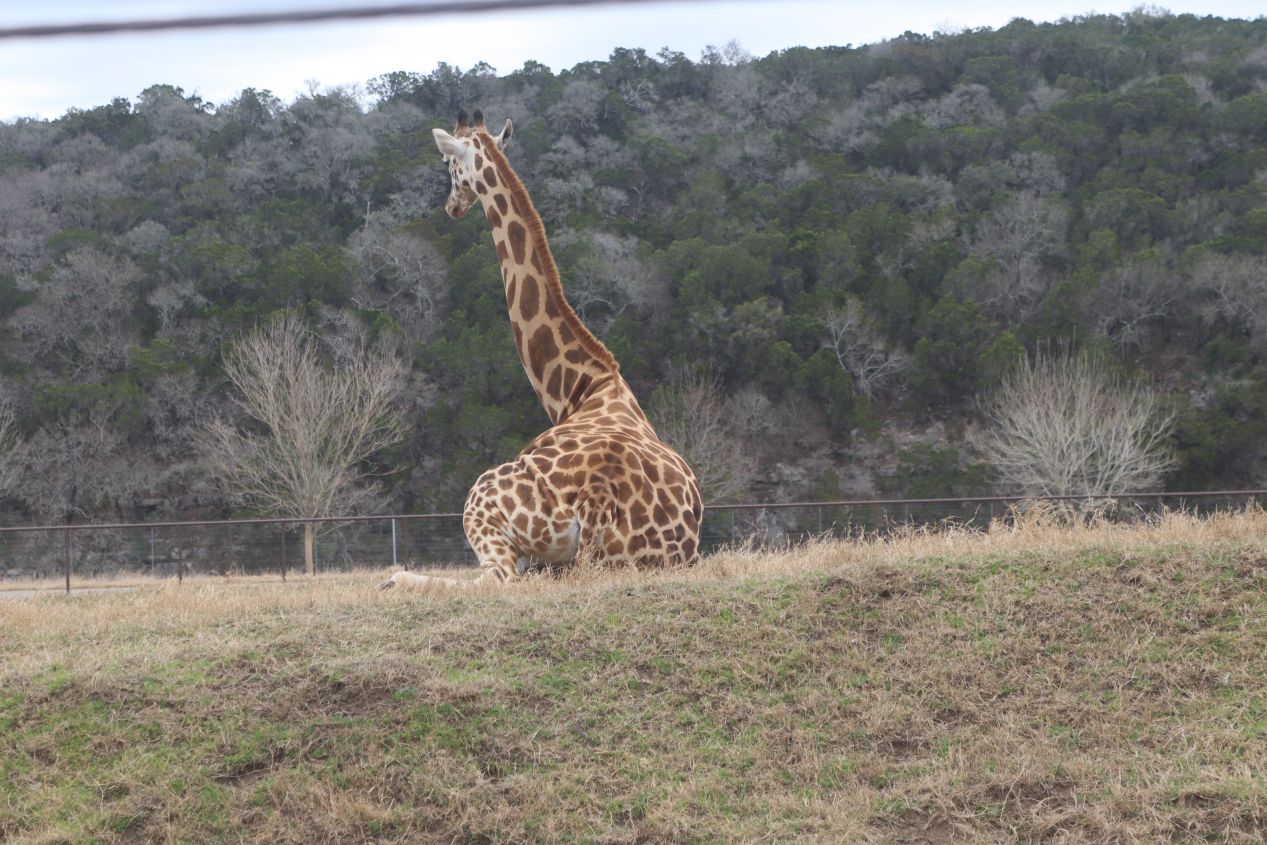


Many of the traditional zoo favorites were present at Natural Bridge as well, more giraffes along with zebras and rhinoes in their own separate enclosures. I had previously learned that giraffes in a herd like to turn so that they all face the same direction, especially when they lay down, which proved to be true once again here. Giraffes have a funny way of sitting down due to their oddly-shaped bodies which I was amusingly able to capture here. The giraffes and zebras and rhinoes were easy to observe from the road but they were all fenced off from interacting directly with the cars driving past. This was perfectly understandable since giraffes and rhinoes are large enough to be dangerous for cars while zebras are well known for having foul tempers. No matter how many warning signs the staff might put up cautioning about danger, they couldn't have a rhino deciding to charge one of the vehicles and potentially kill someone.

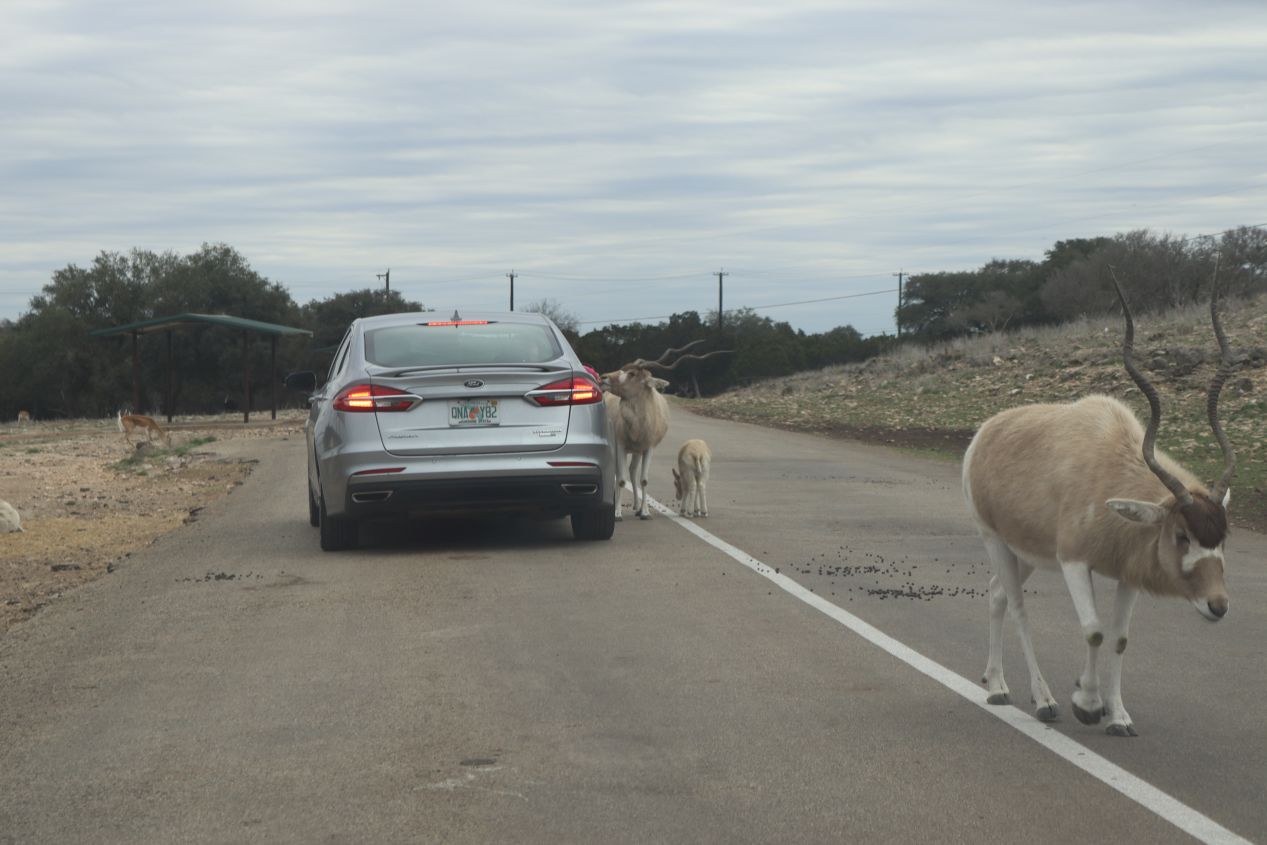


The final portion of the Wildlife Ranch was an area named the Kenyan Preserve featuring more animals that were mostly from Africa. There were more ostriches here and I spotted some of the other visitors rolling down their windows to take pictures of the birds in a way that was definitely not safe. There were also a bunch of animals with truly wild horns named addaxes which were another type of antelope native to the Sahara. They are another critically endangered animal and therefore it was good to see some baby addaxes accompanying the rest of the herd as they searched for food from passing cars. Finally there were also several emus in this part of the safari park, a bird which definitely did not come from Africa and hails instead from Australia. Emus are the third-largest birds in the world and their presence meant that Natural Bridge had three of the four largest types of birds in their safari park. (They lacked the cassowary, the second-largest bird in the world, for obvious reasons because cassowaries are very dangerous animals and have killed a number of humans with their razor-sharp foot talons. Not something that would be safe at a place like this.)
That brought my time at Natural Bridge to a close as well as my brief time spent in San Antonio. I made the return drive back to Austin and turned in the rental car after a single day's use; the dealership had hilariously given me a free upgrade to a red sportscar because they probably had so few other clients renting from them at the time. I enjoyed having the chance to visit San Antonio and experience once again many of the same places that I had seen almost three decades earlier. This is a great city to visit with kids between the River Walk, the various historic attractions, and the various theme parks that I barely touched upon in this report. I would also very much recommend Natural Bridge and its wildlife ranch to anyone who enjoys animals since this was a rare experience that would otherwise require traveling much further afield. Thanks as always for reading this short writeup of a day spent in southern Texas.



